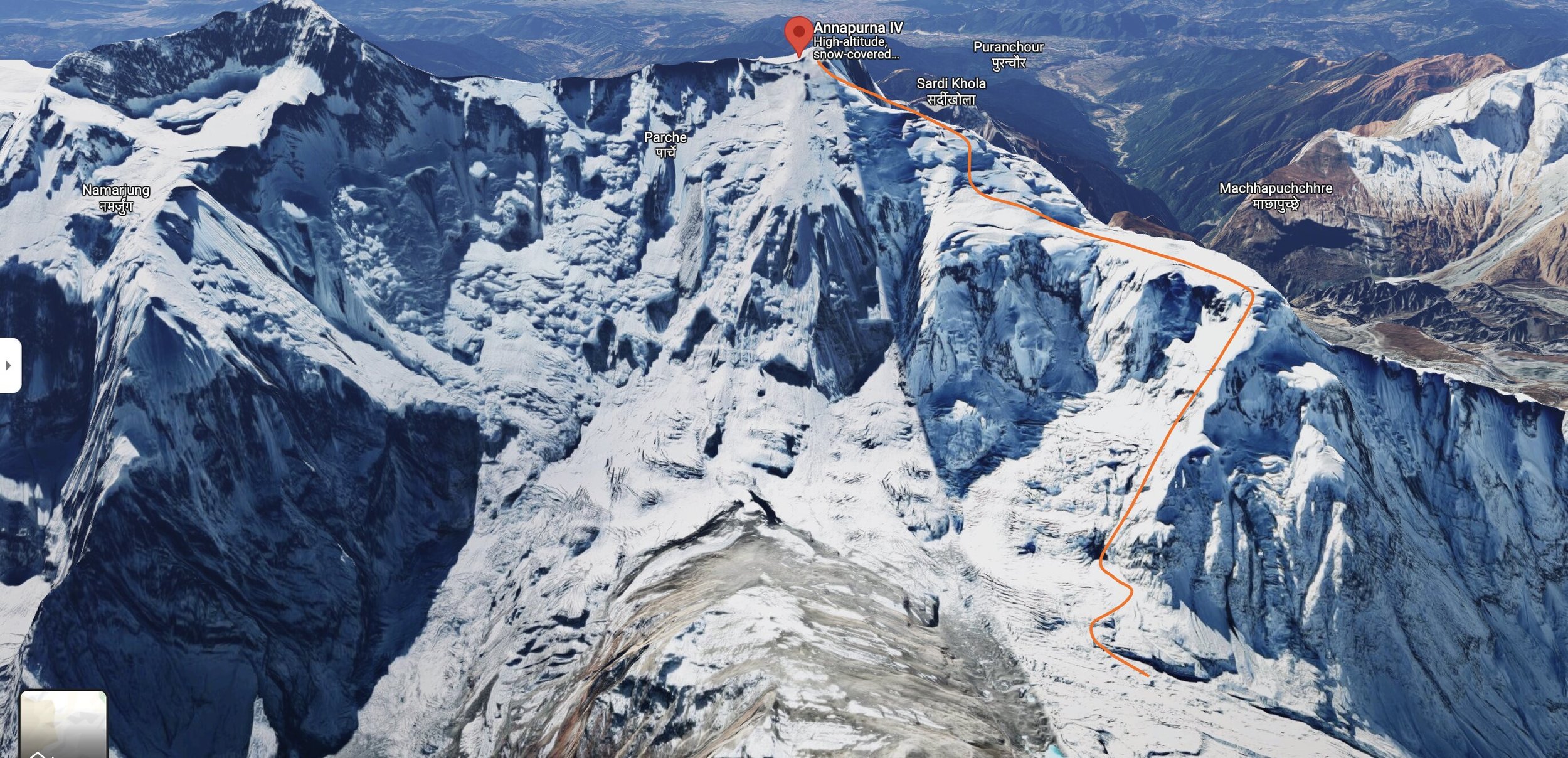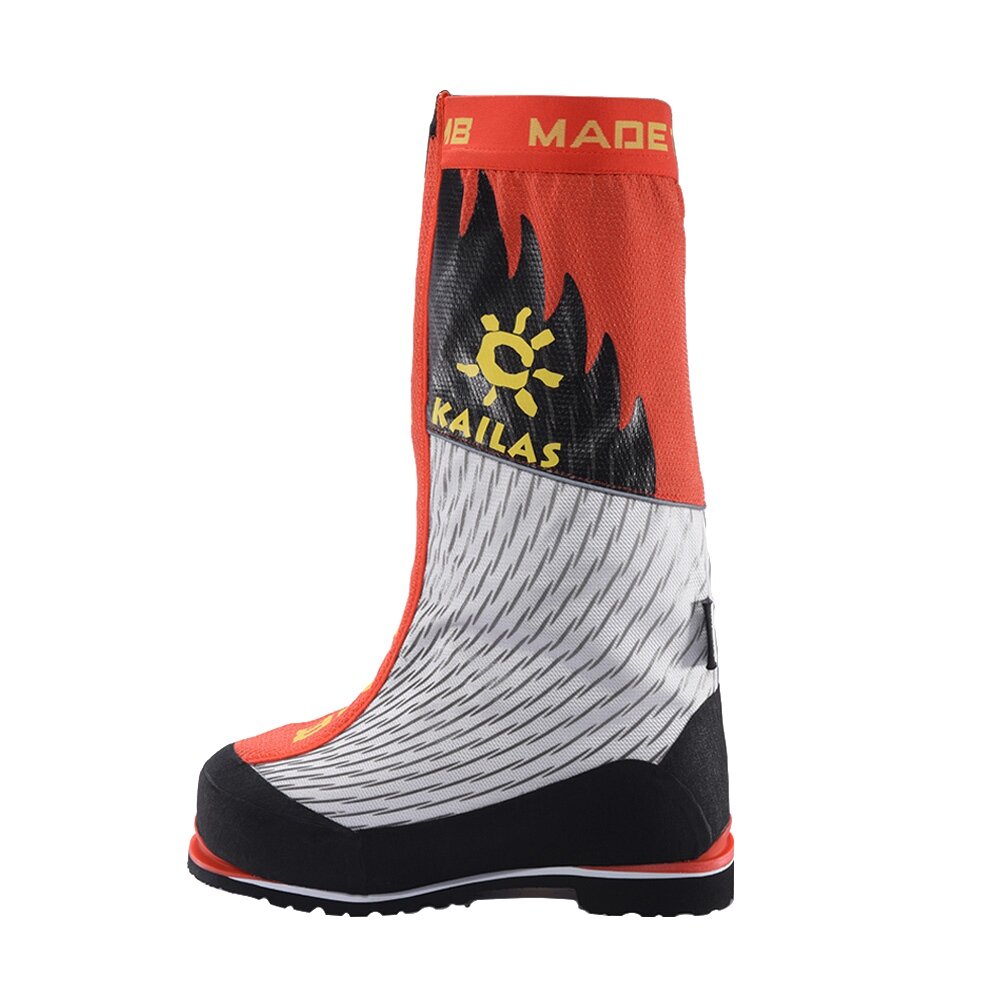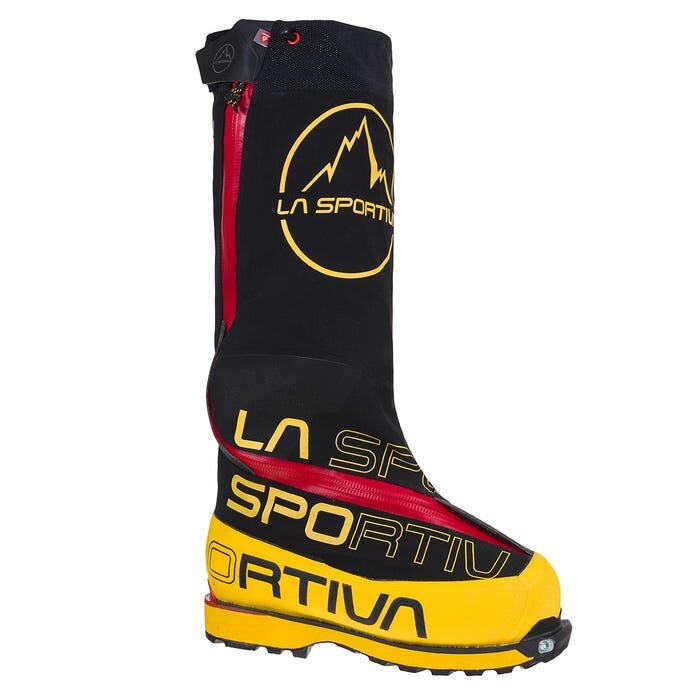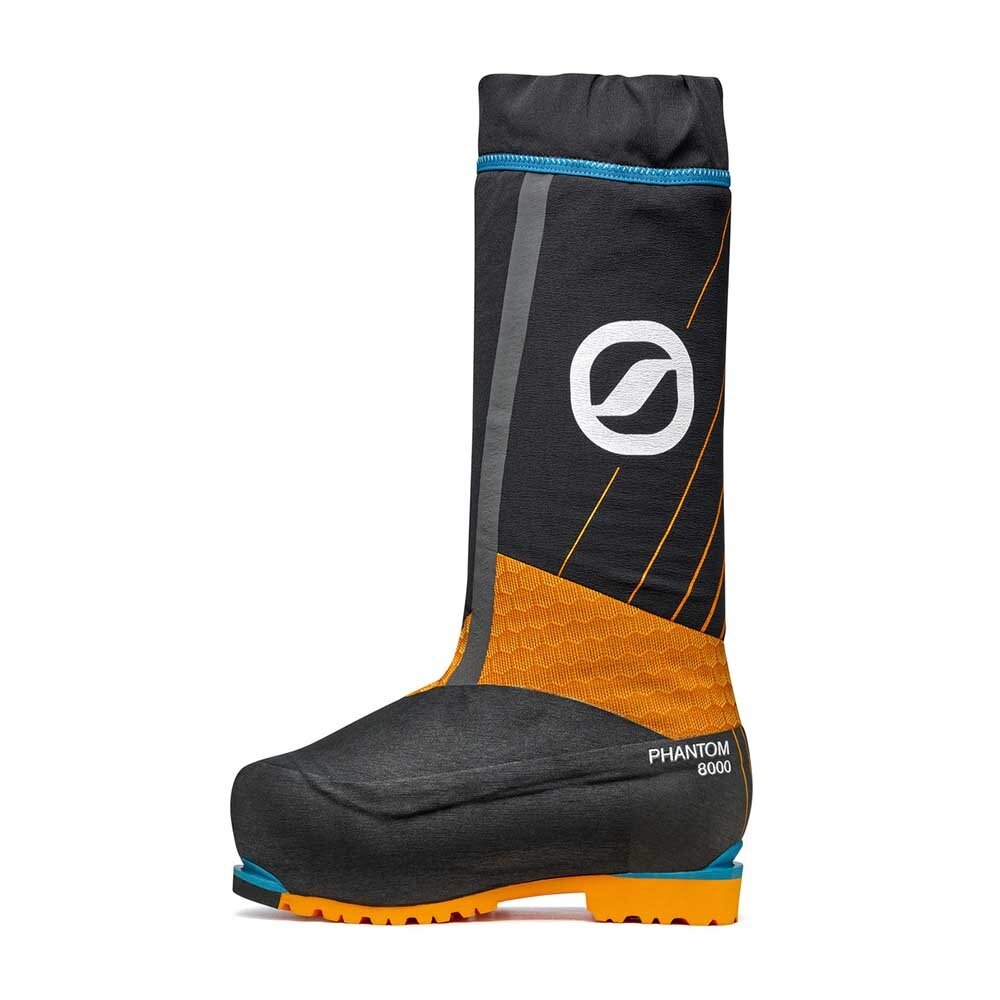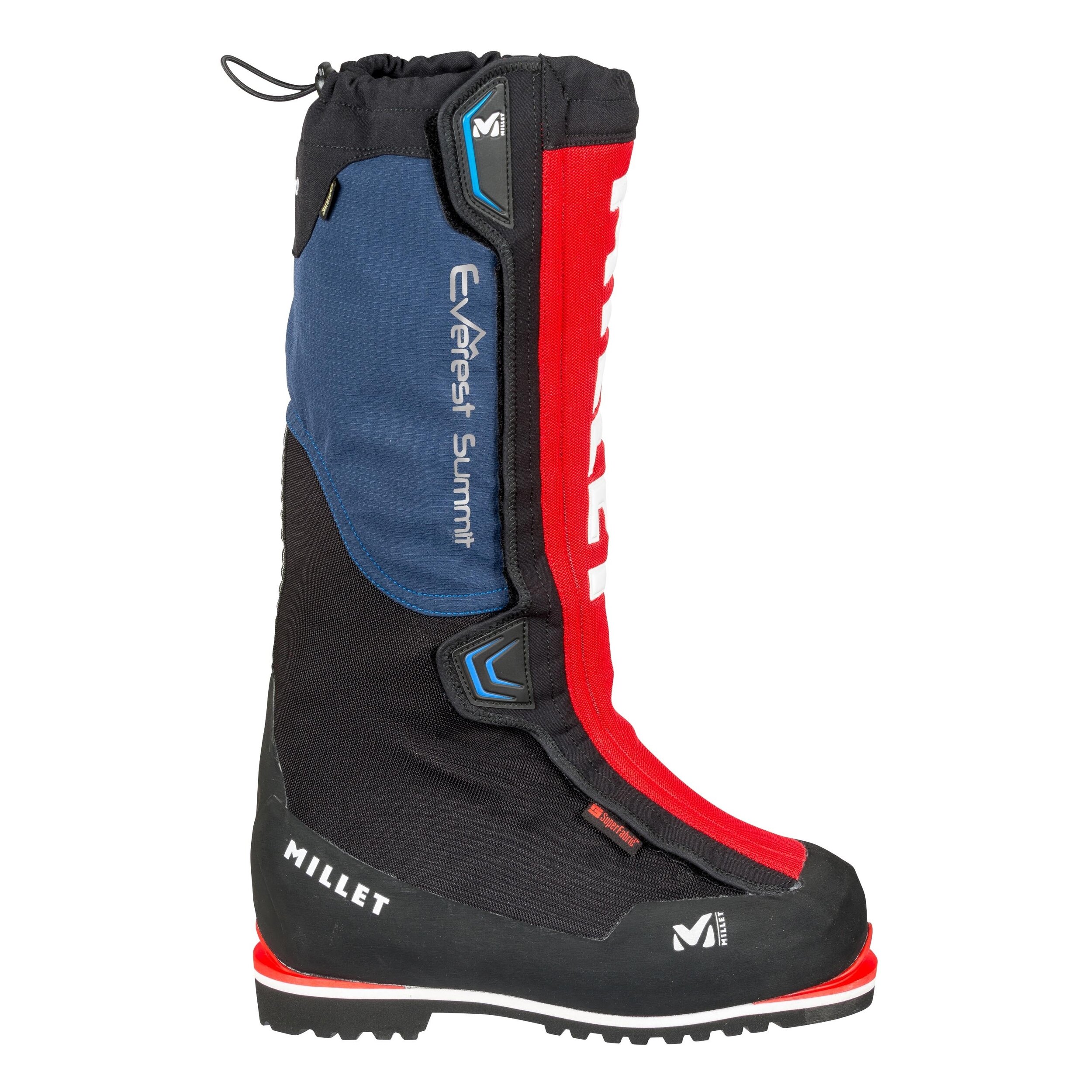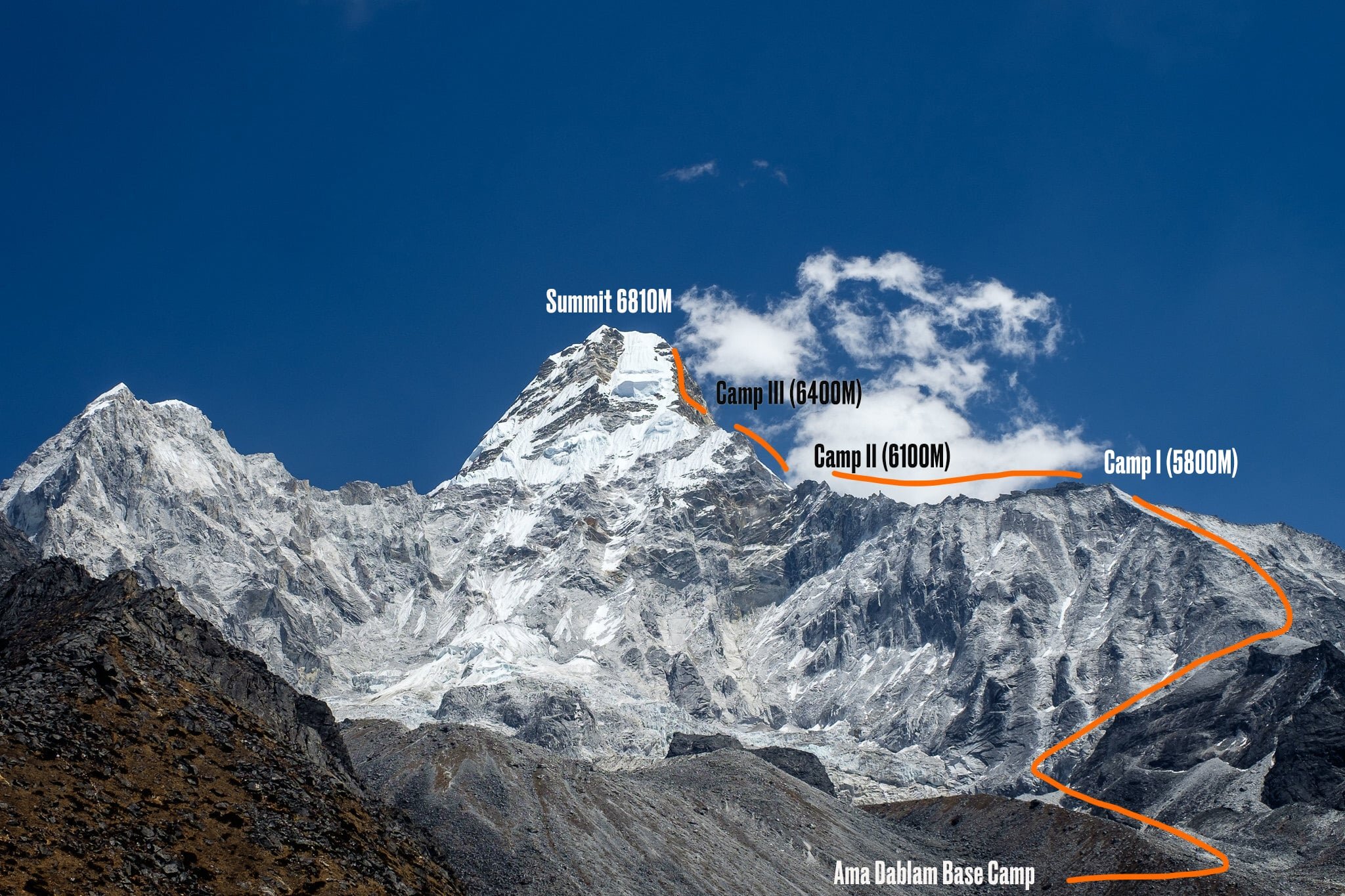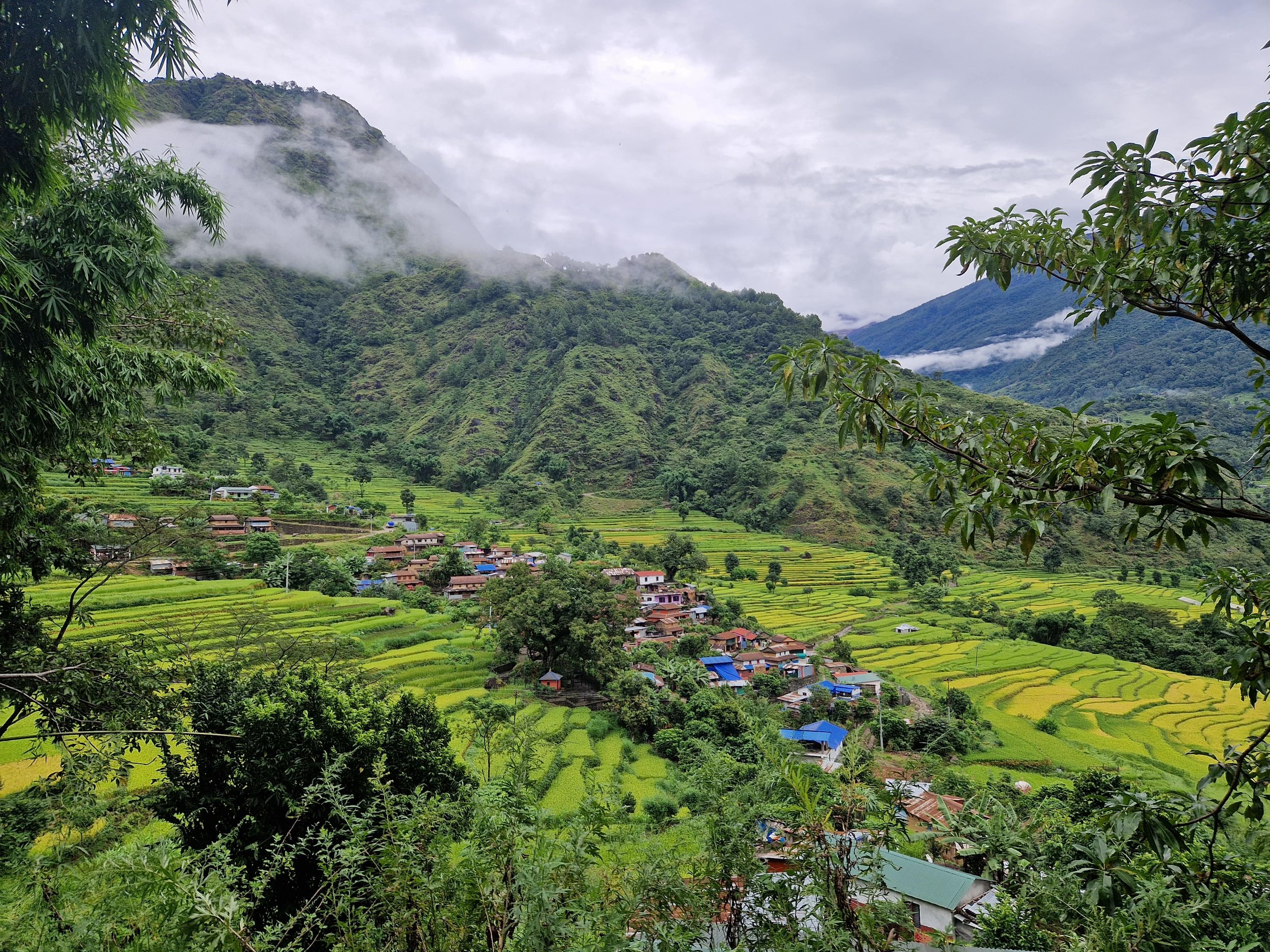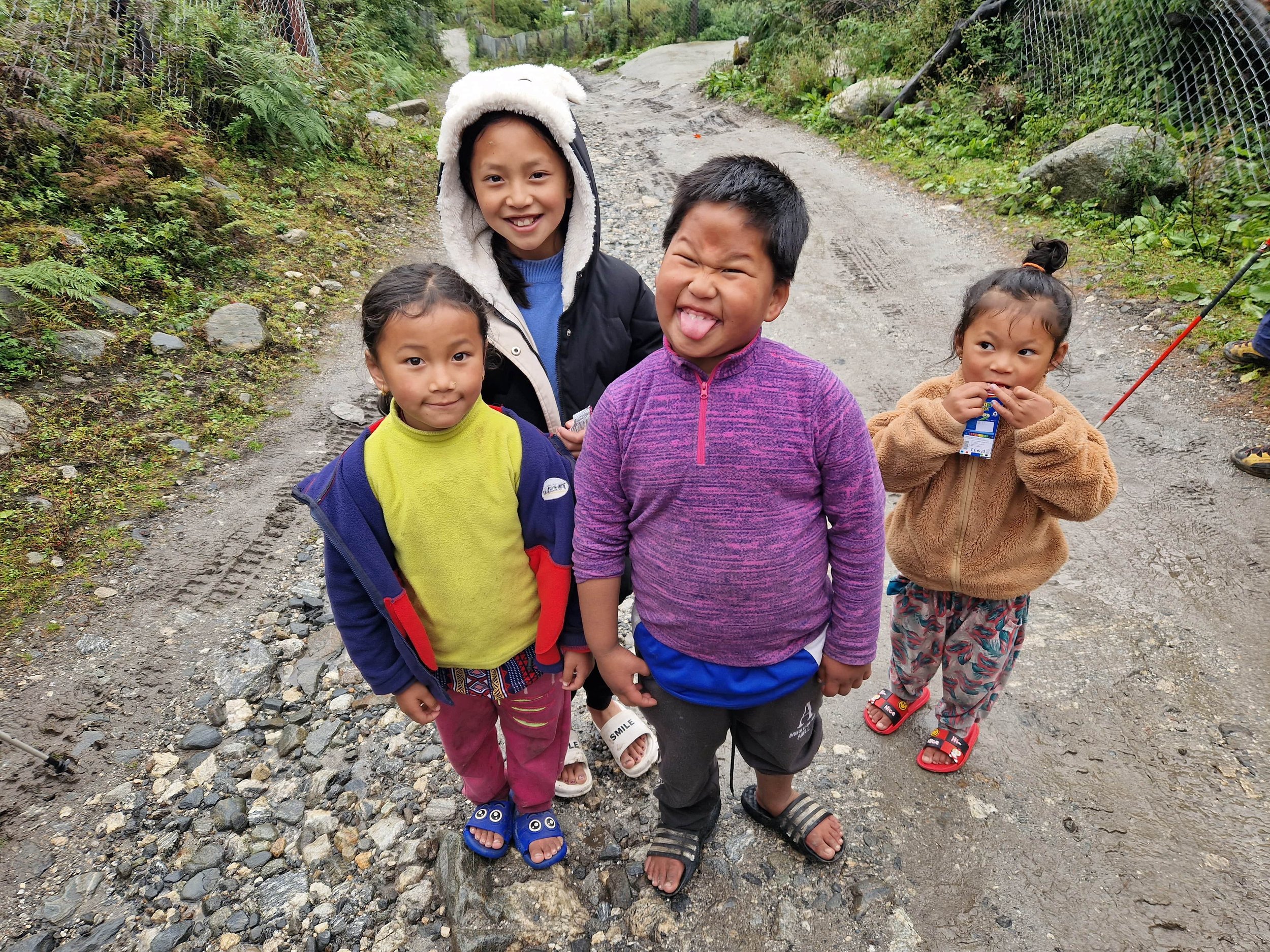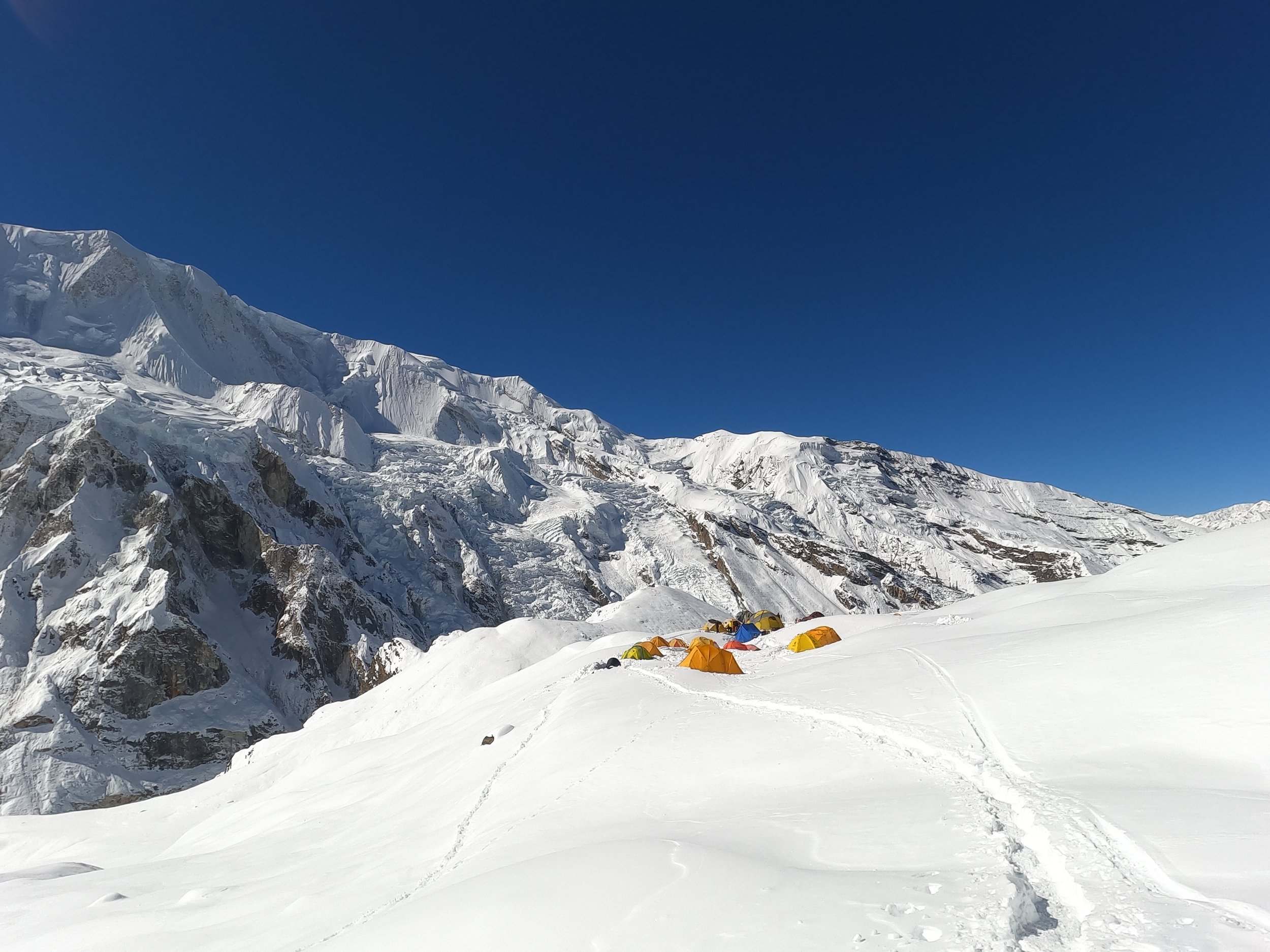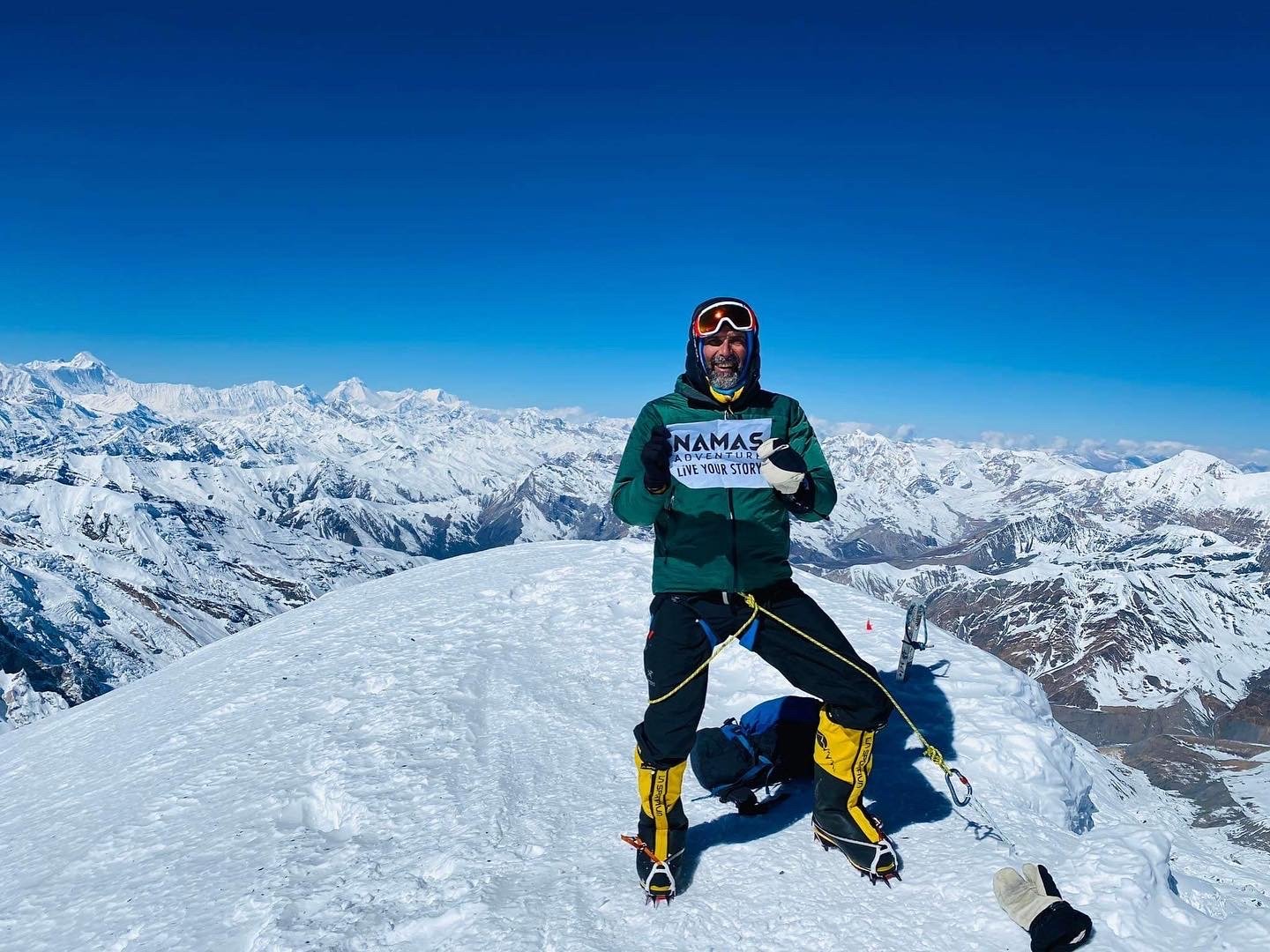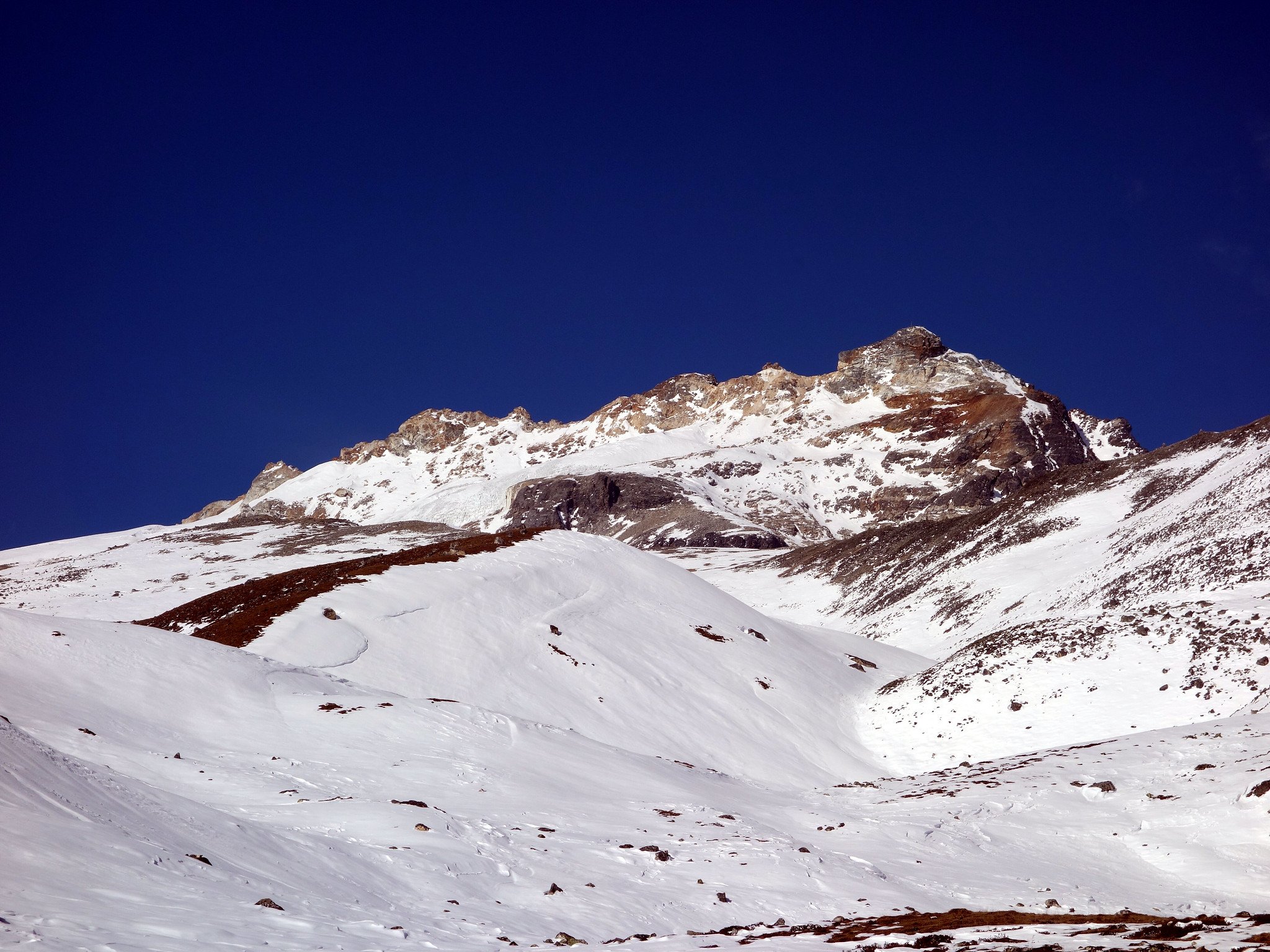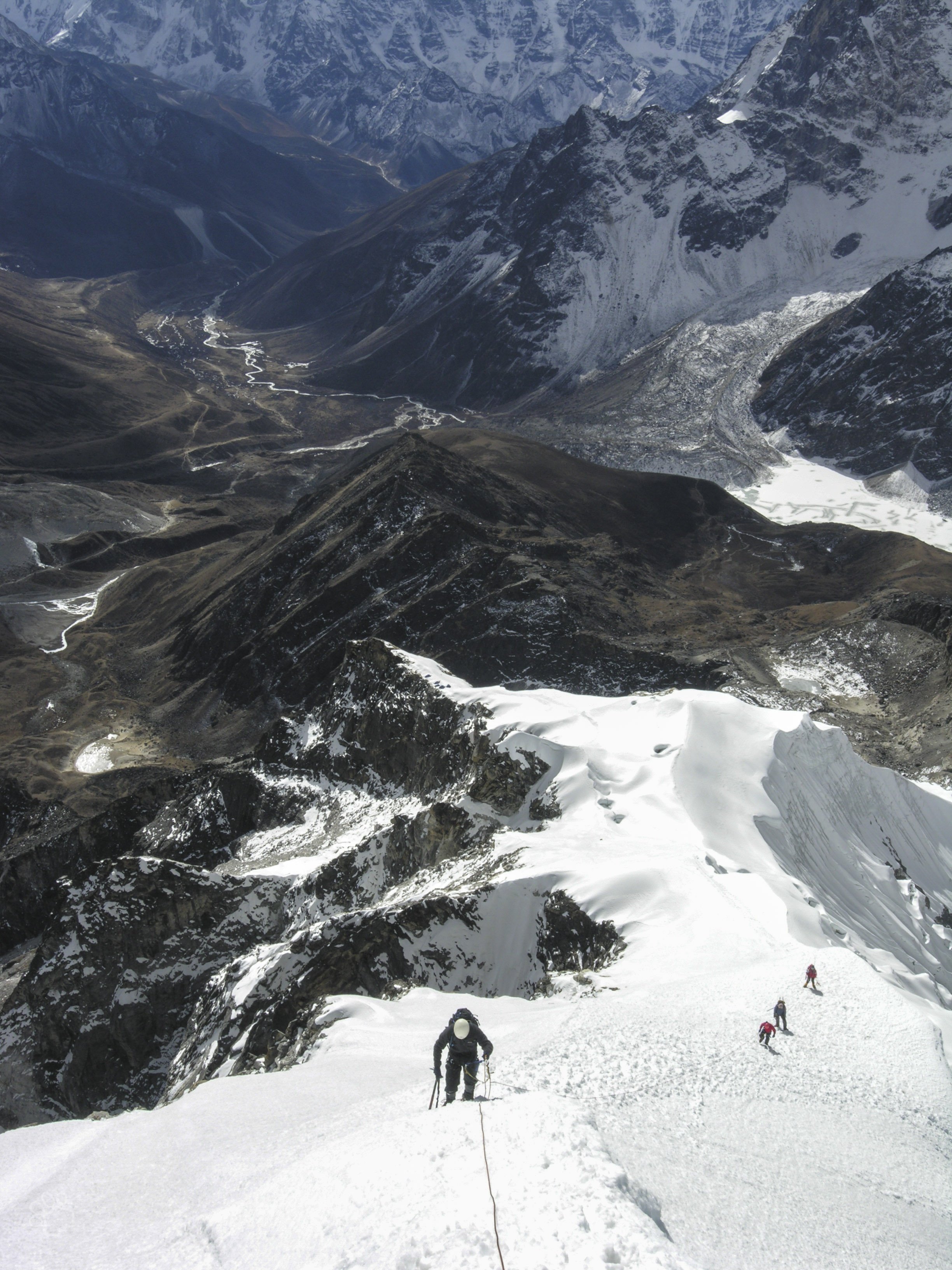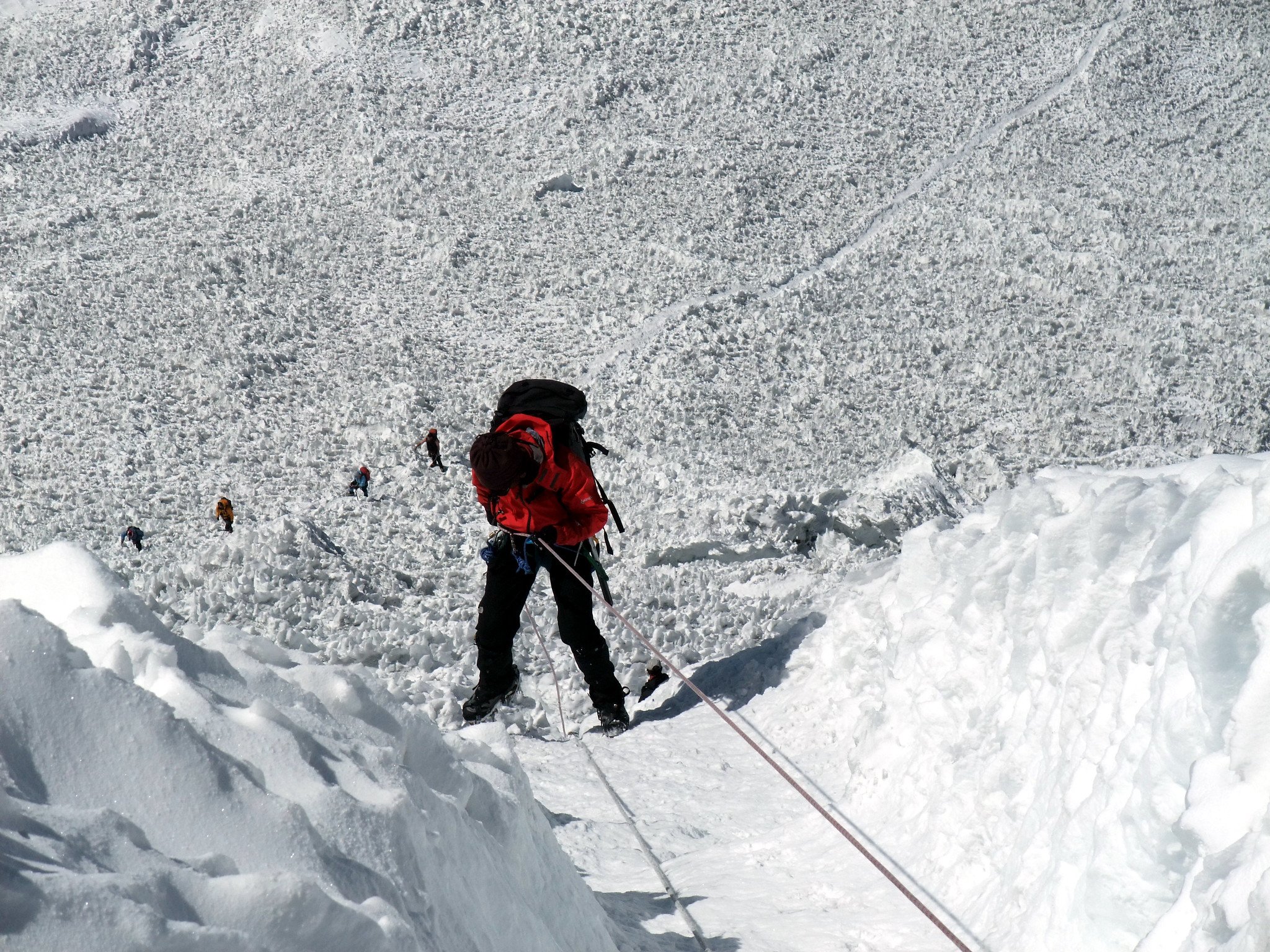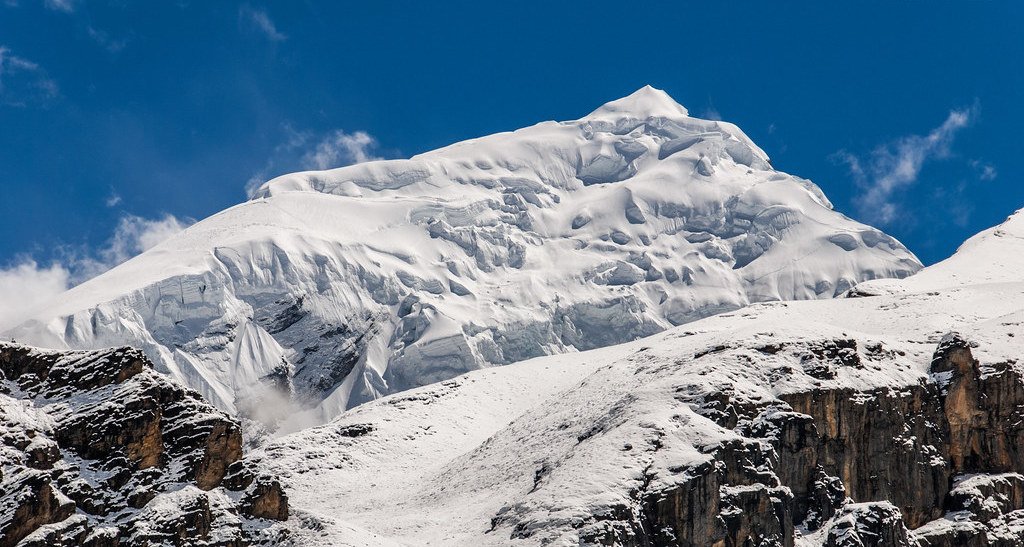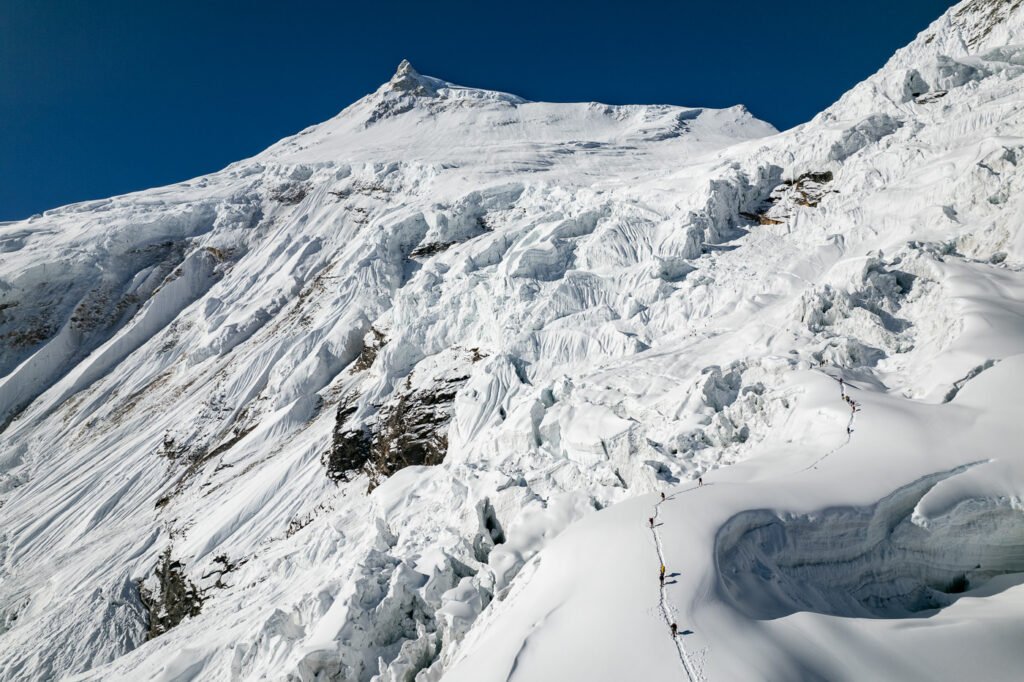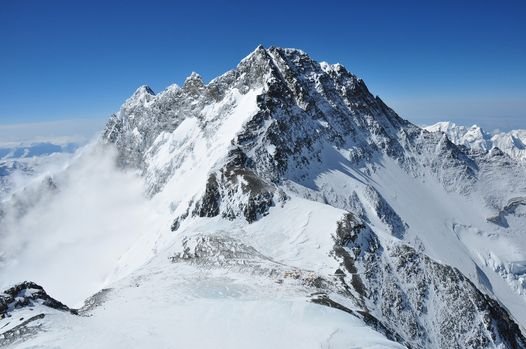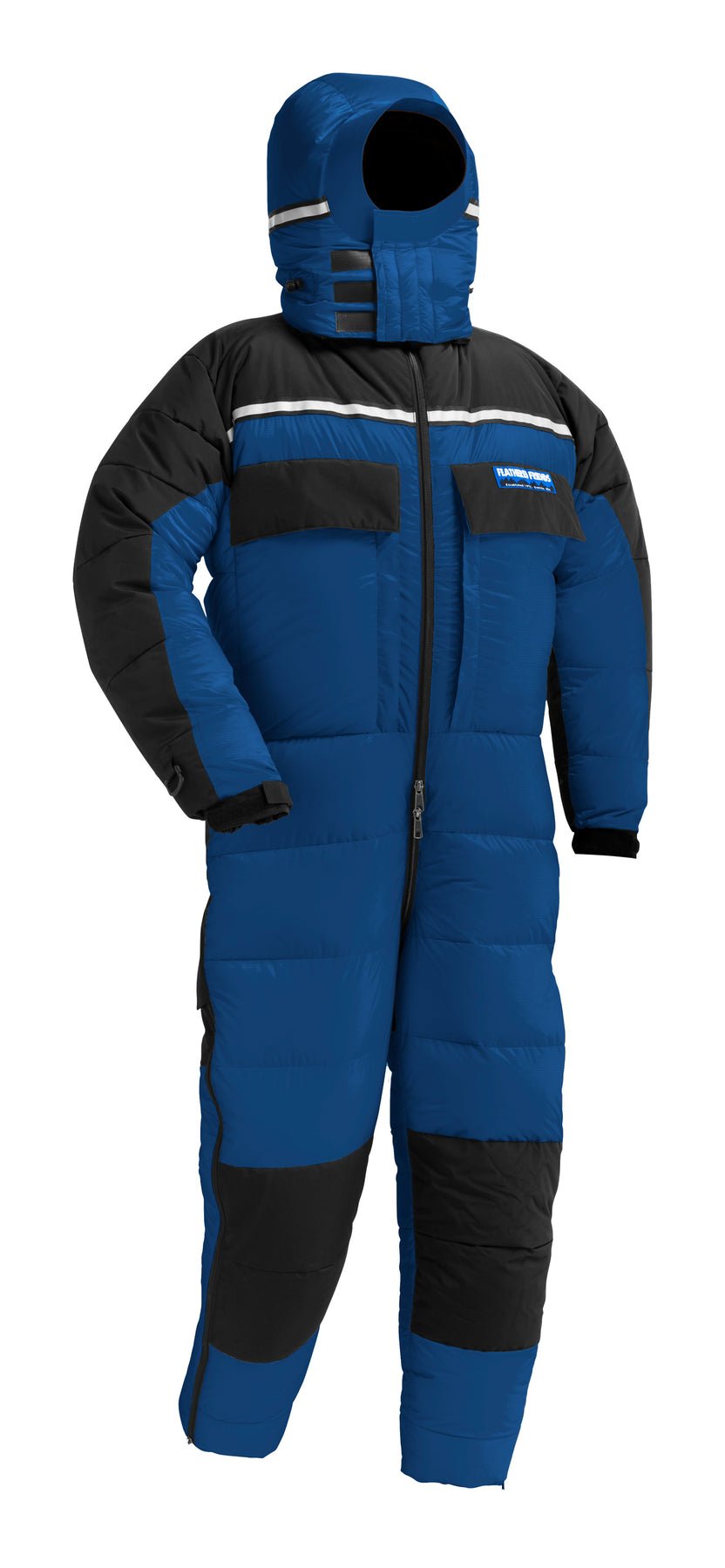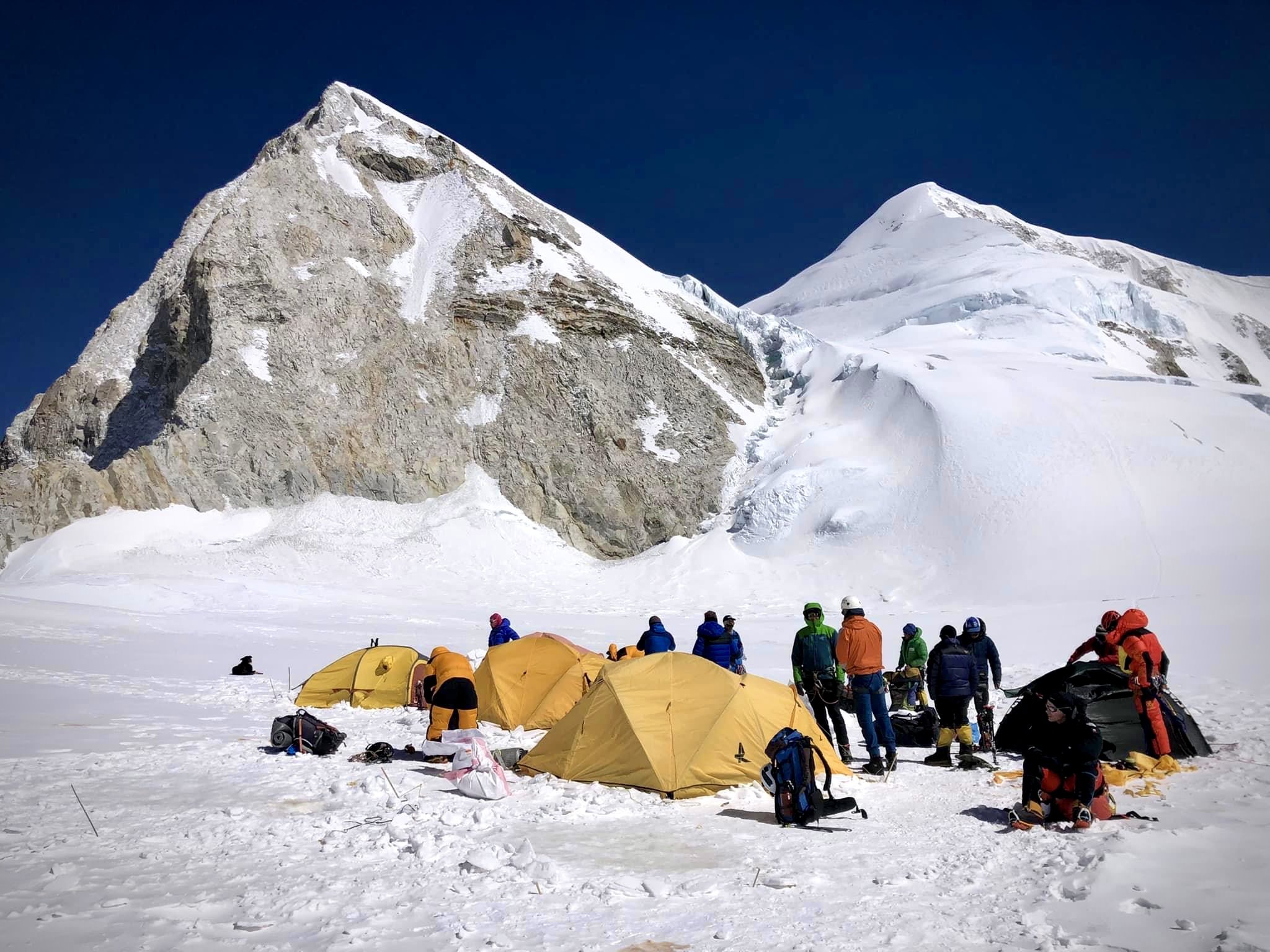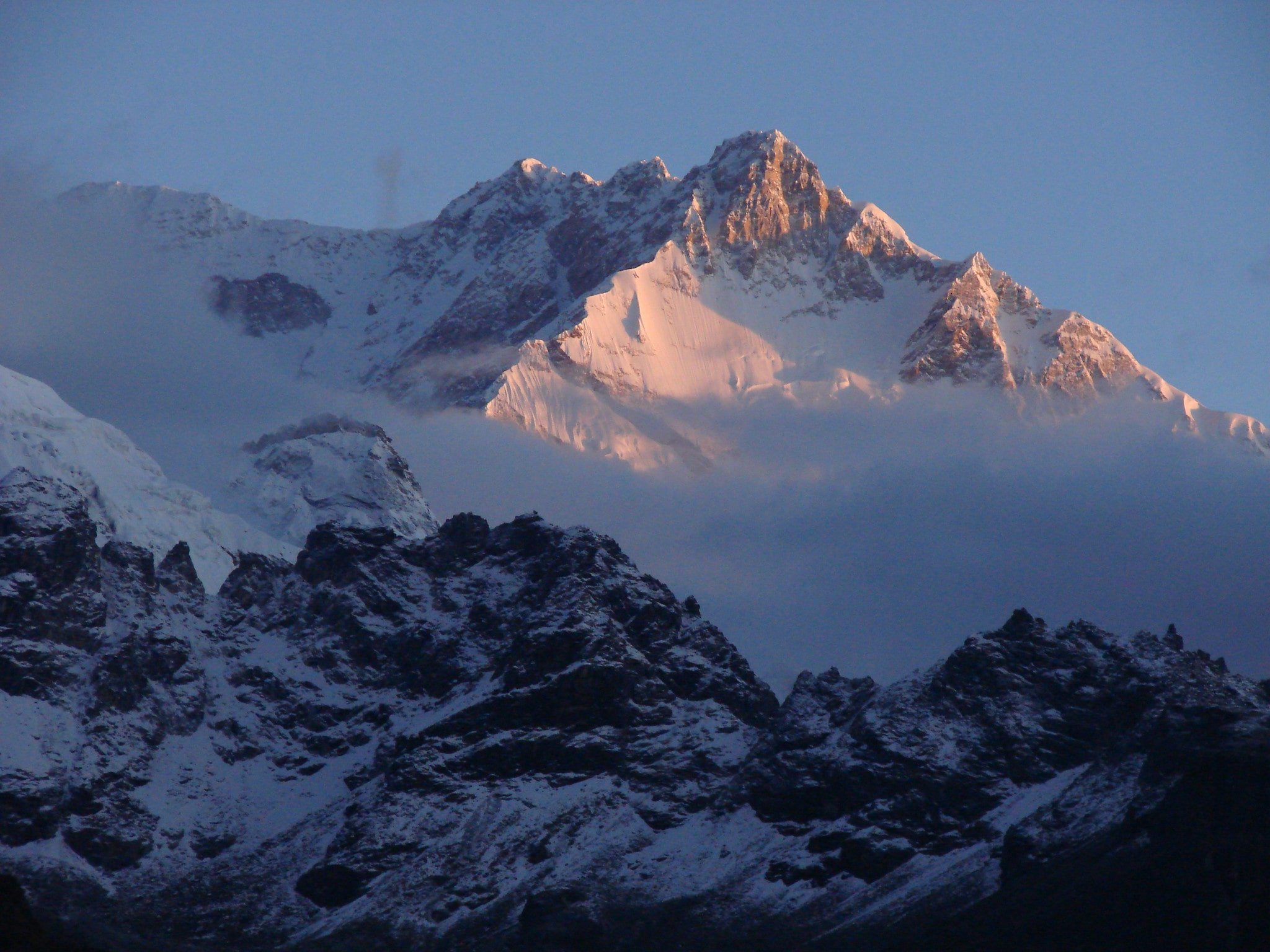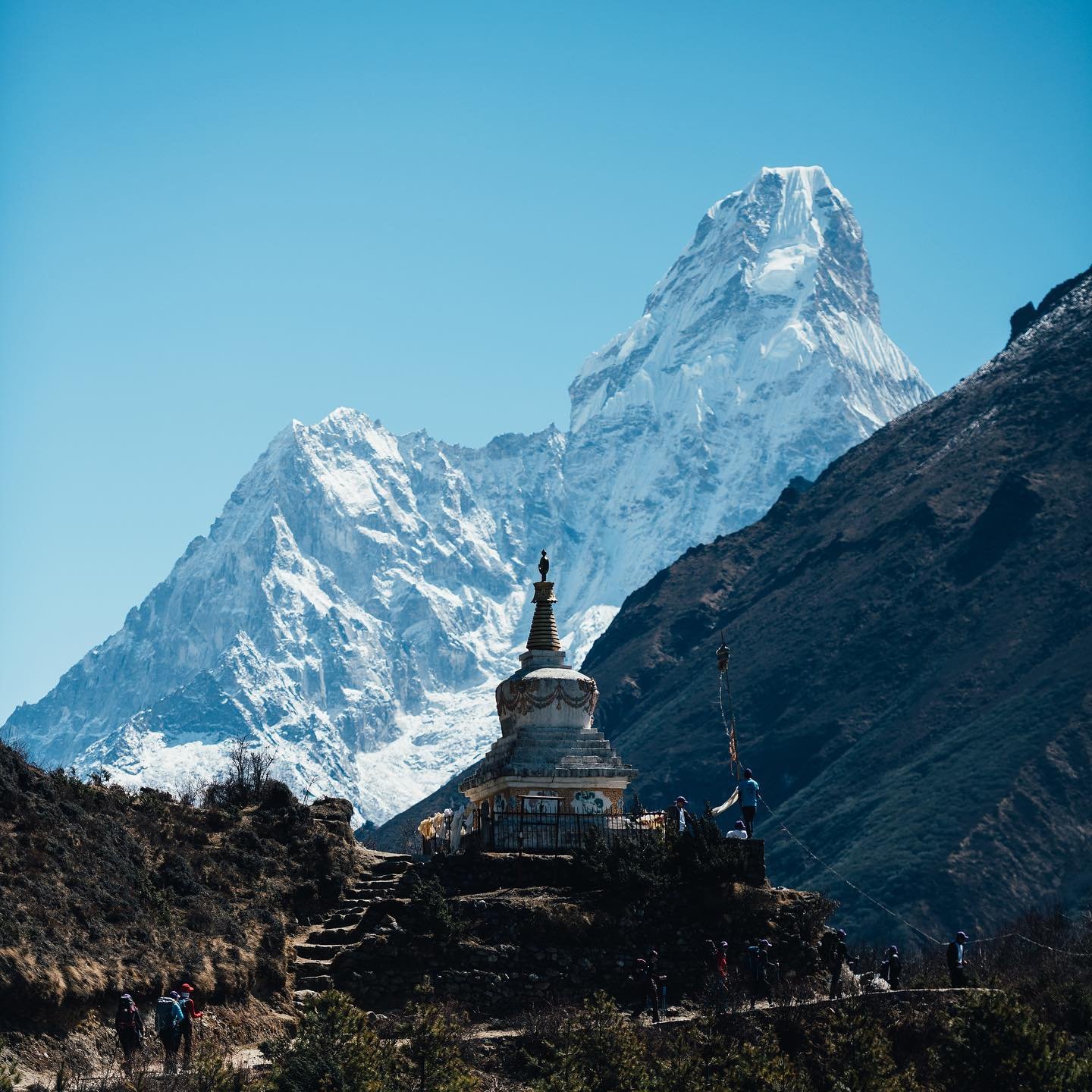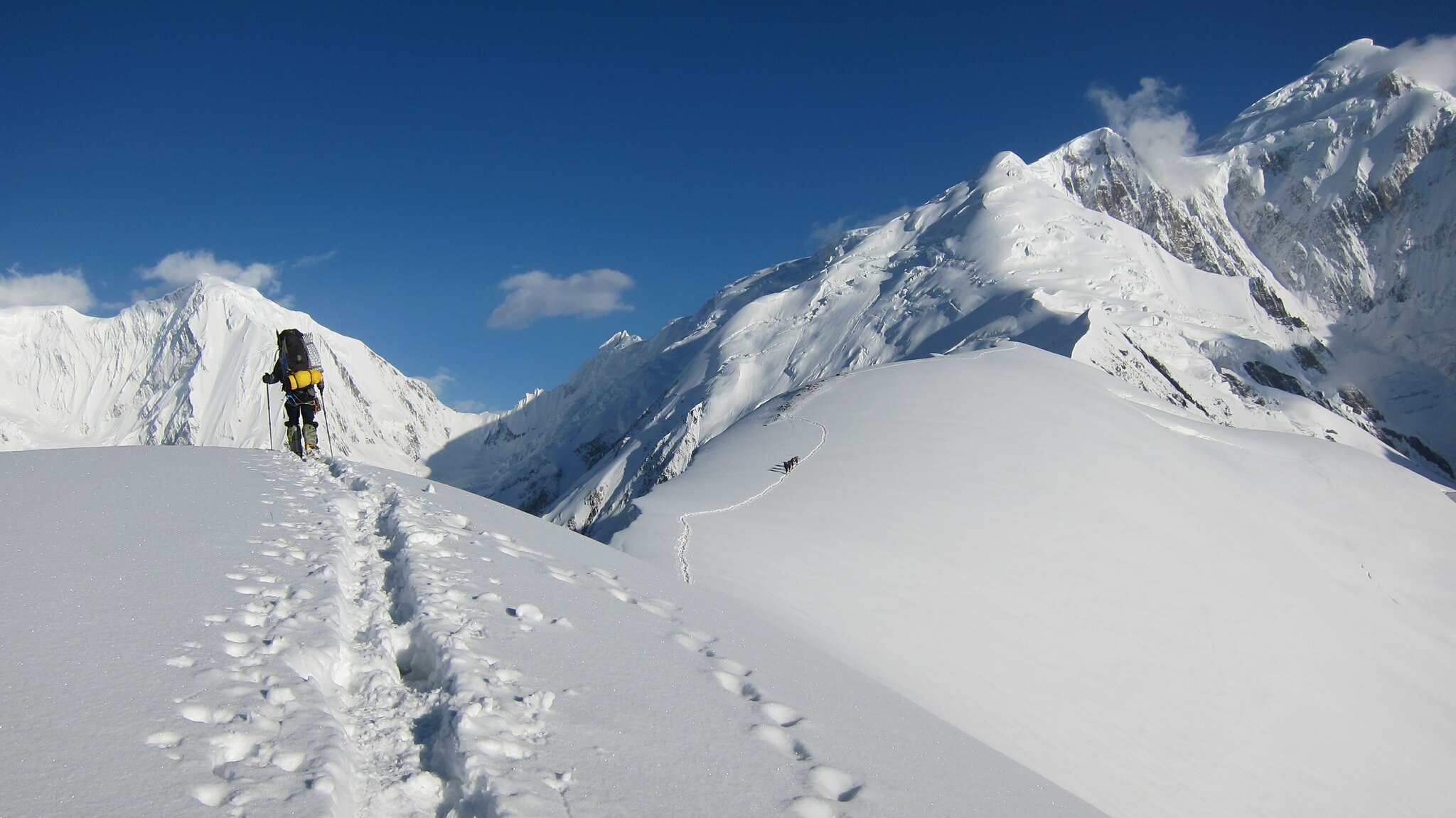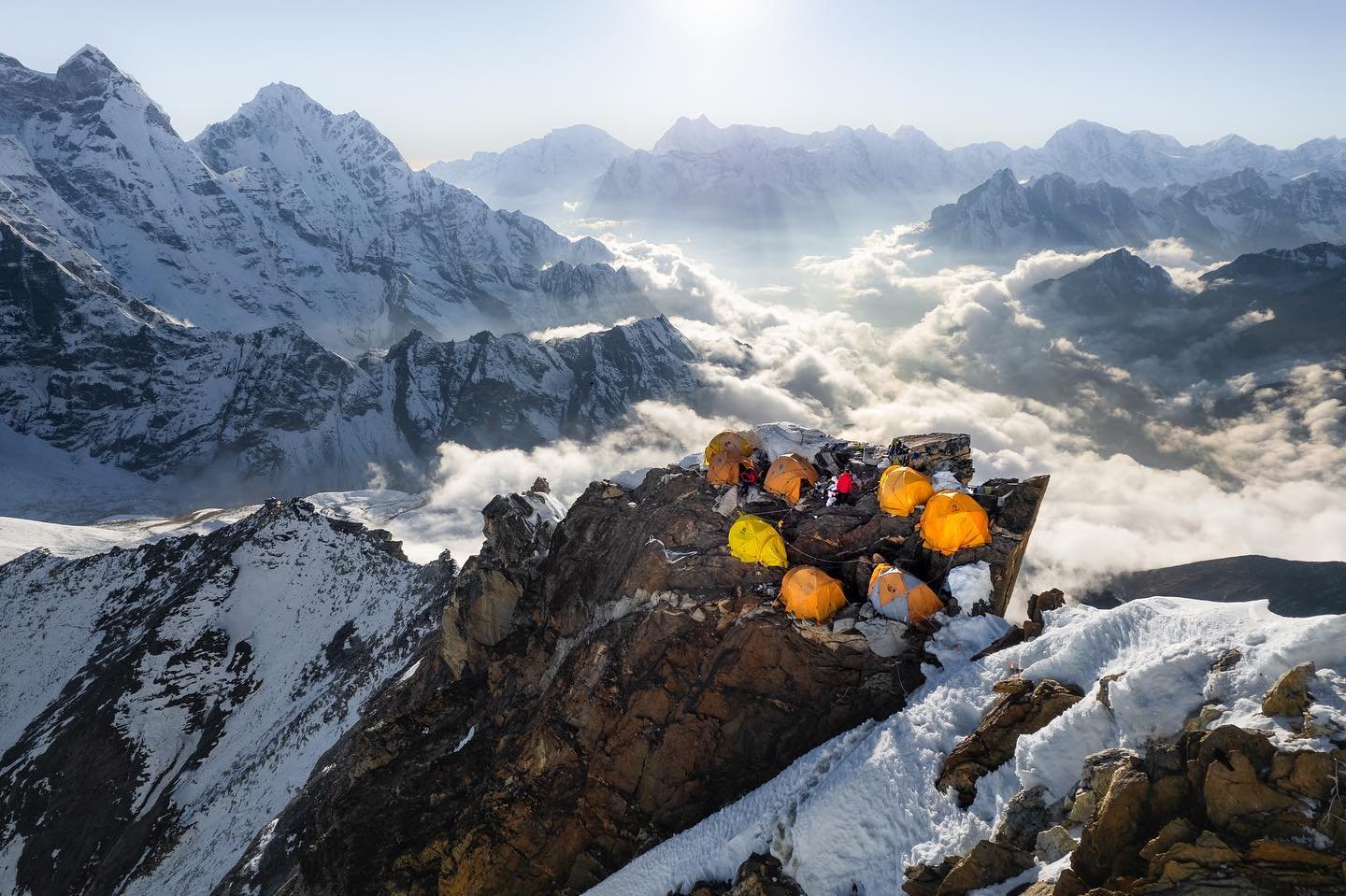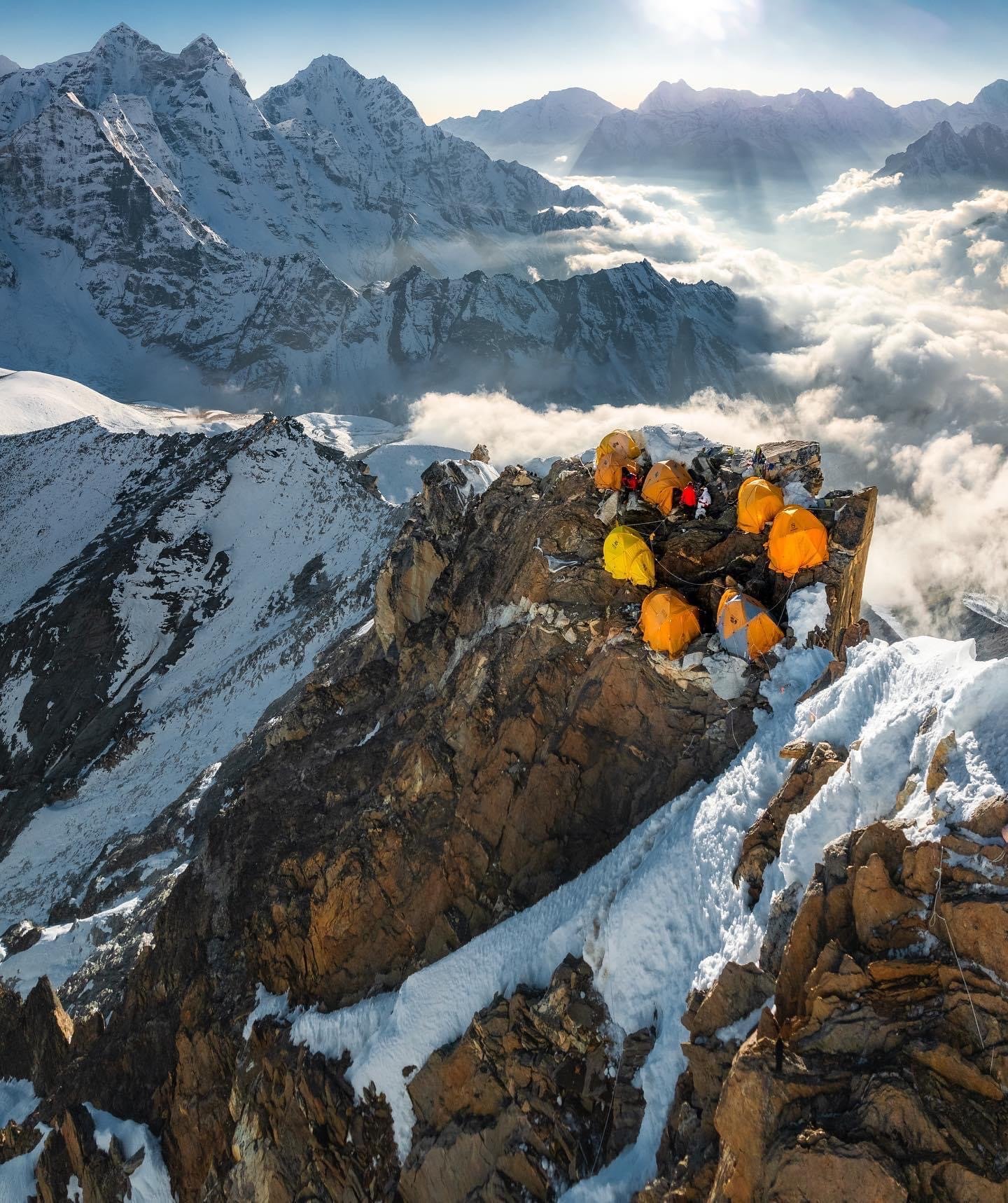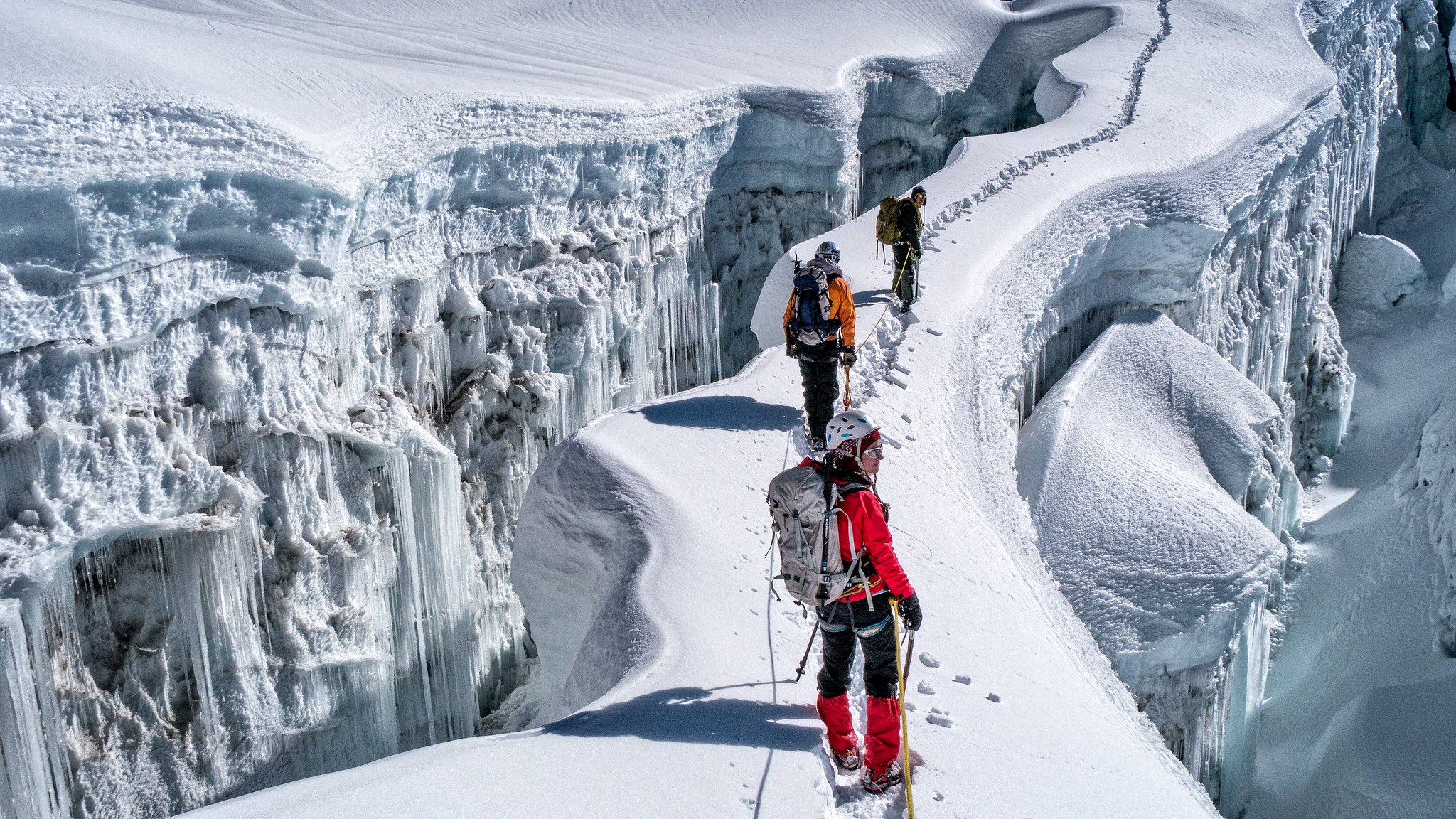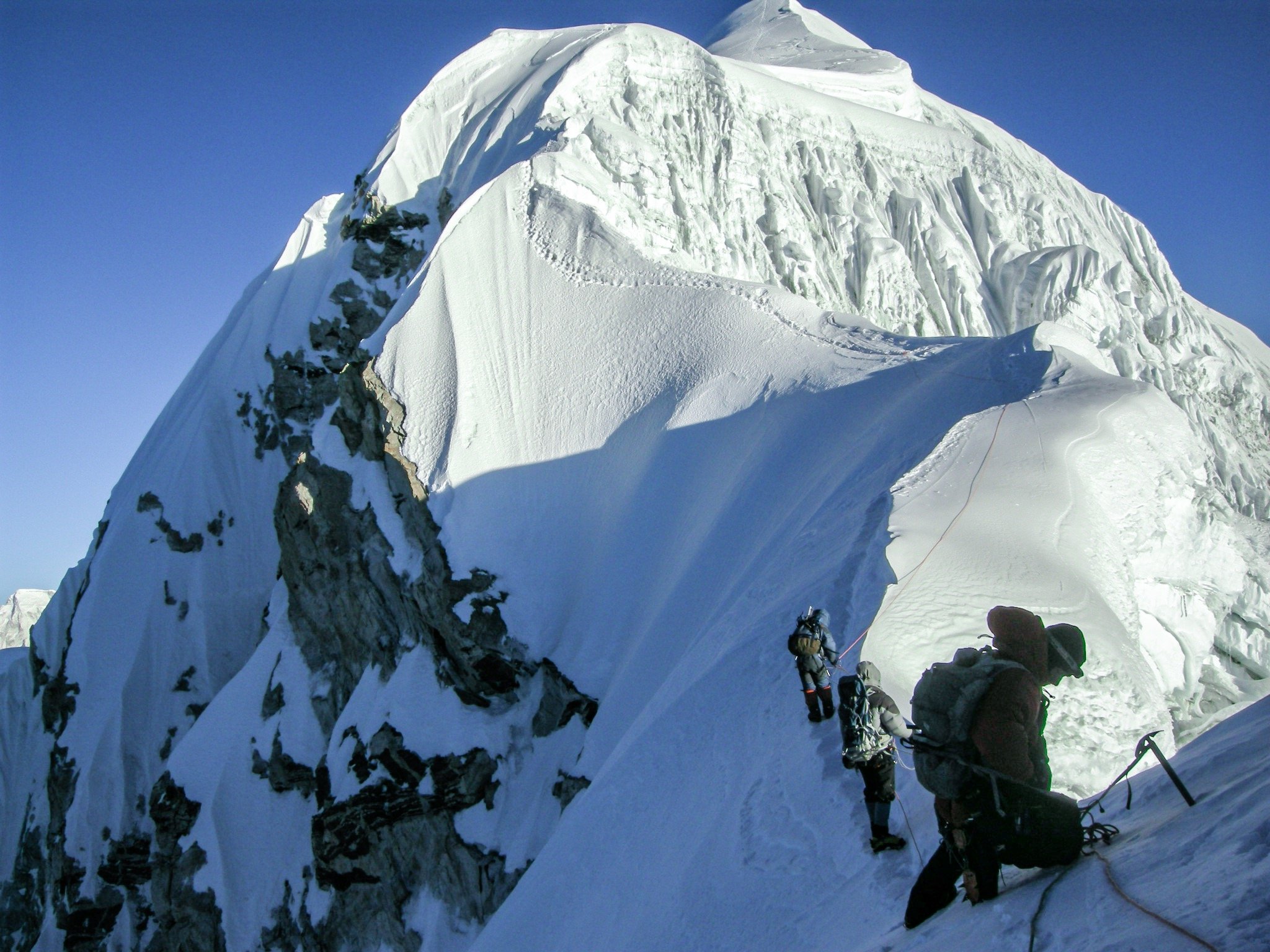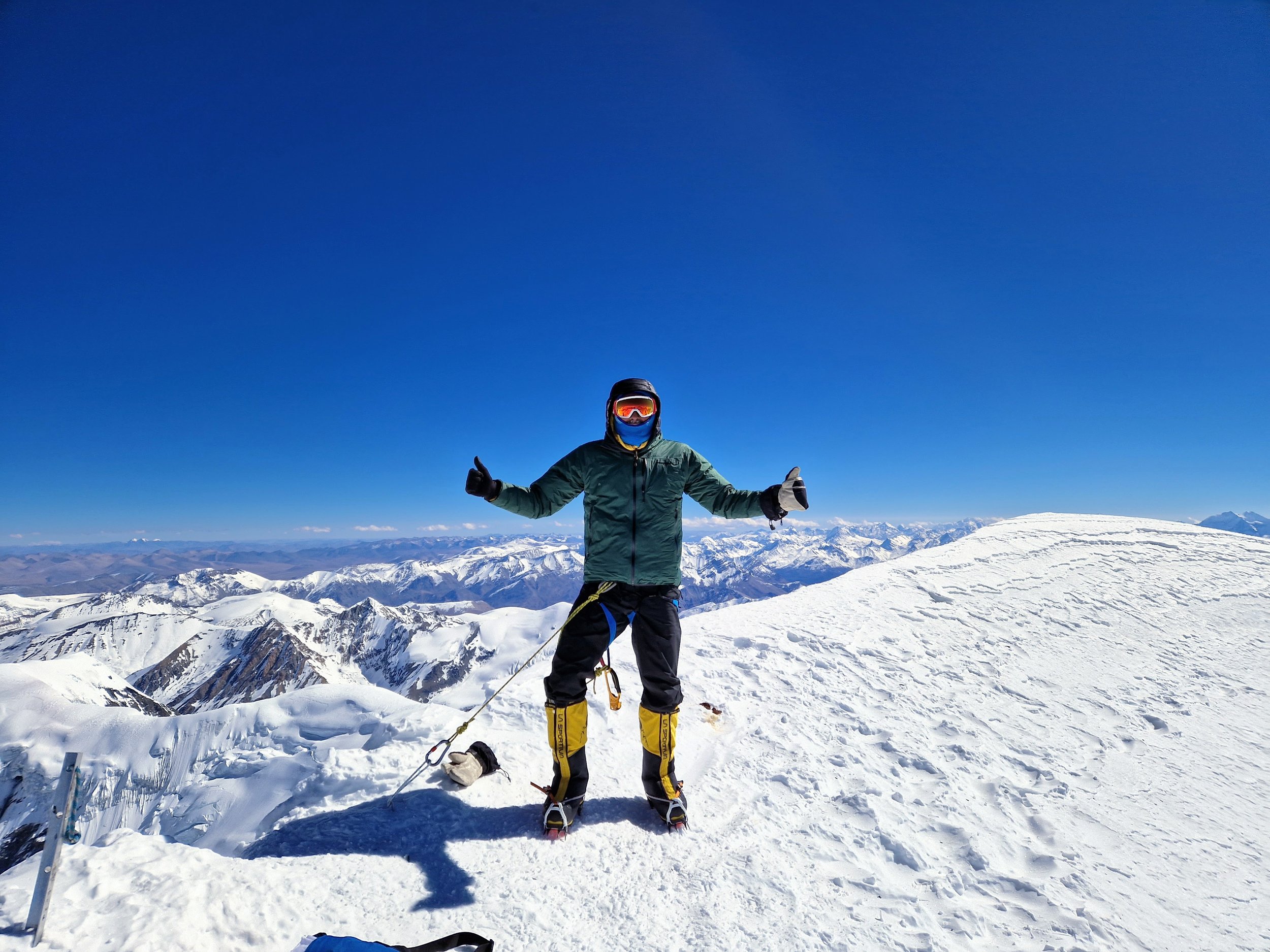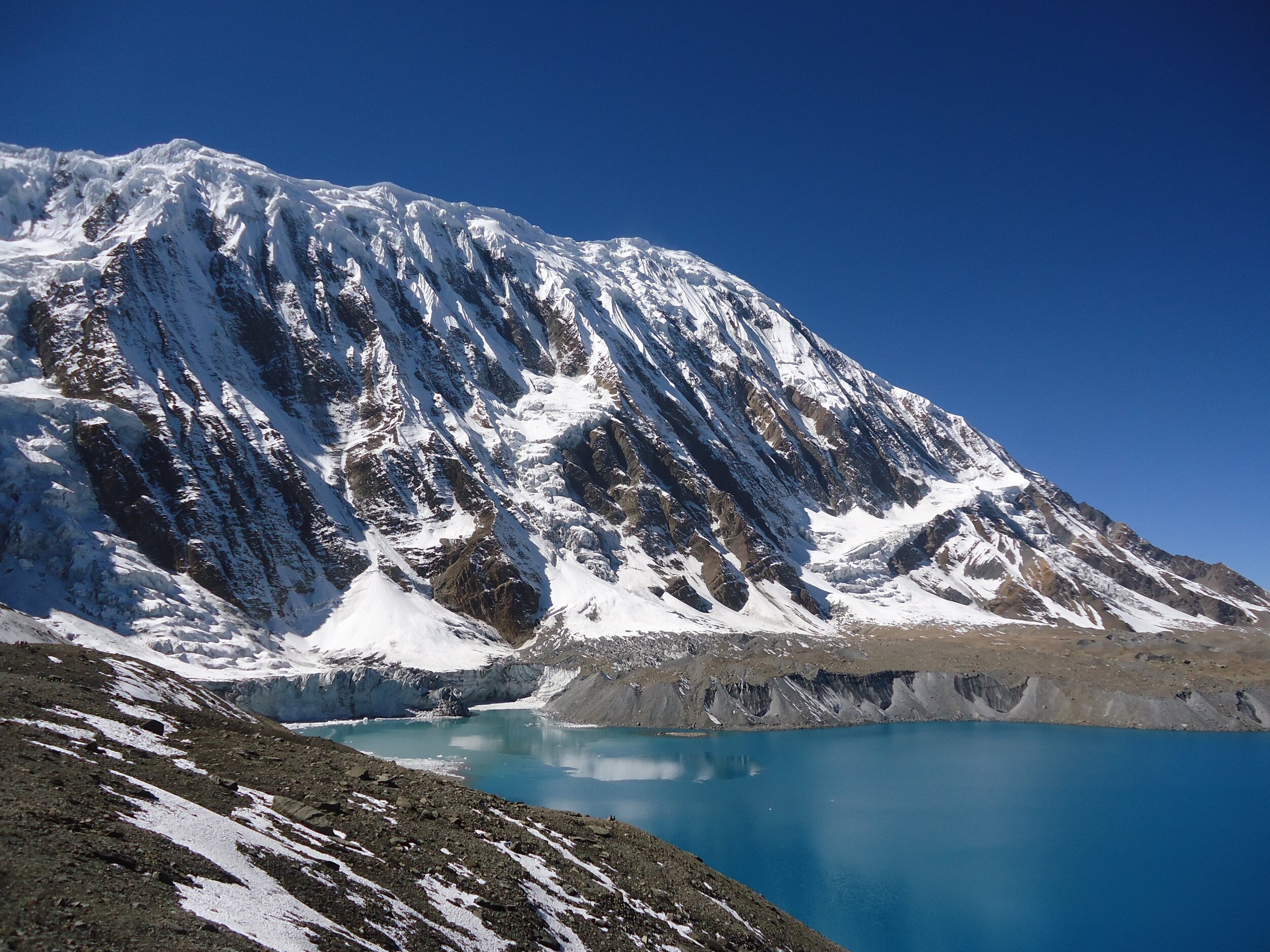Why Choose Cho Oyu as Your First 8000M Climb? Discover what Makes Cho Oyu the Safest and Easiest 8000M Expedition - Namas Adventure
In this blog article discover why climbing Cho Oyu (8201m), the world's 6th-highest mountain is considered one of the easier and safest 8000m peaks to climb:
Elevation - At 8,201m, Cho Oyu is in the lowest category of the 8000m peaks, so there is slightly less altitude to acclimatize to compared to giants like Everest (8,848m) or K2 (8,611m).
Standard Route - The normal West Ridge route is relatively straightforward, with no major technical sections or steep pitches. It involves mostly moderate to steep snow climbing.
Gradient - The slope gradients on the standard route don't exceed about 30 degrees, making it less steep than other major 8000ers.
Weather - Cho Oyu sees less severe weather compared to the peaks in the western Himalayas. The post-monsoon season has relatively stable weather.
Camps - There are only 3 camps from the Advanced base camp to the summit, limiting the amount of gear hauling required.
Sherpa Support - 1:1 Sherpa guide with additional Sherpa team for logistics support. Experienced Sherpa teams fix ropes and establish camps, providing crucial support.
Previous Experience mandatory checks- Most climbers tackle Cho Oyu after building experience on lower several 6000M and 7000m peaks first. The Chinese authorities are very strict when approving permits and only allow climbers with proof of a previous 7000M summit certificate to climb Cho Oyu.
Fatality Rate - Historically, Cho Oyu has had a lower death rate compared to other 8000ers. Proper preparation greatly minimizes risks.
In conclusion, Cho Oyu 8201M emerges as an attainable choice for climbers embarking on their first 8000m peak, thanks to its manageable technical difficulty, safely positioned higher camps, and the invaluable support of experienced Sherpa teams. While it offers a relatively lower fatality rate, it is crucial to approach Cho Oyu with the utmost respect and thorough training. Adequate preparation remains paramount to ensure a safe and successful climb.
Are you ready to embark on your dream of climbing an 8000M peak with the lowest fatality rate? Look no further than our Cho Oyu 8201M Expedition. We pride ourselves on keeping our team small and agile, ensuring a high-quality experience focused on your safety and summit achievement. Join us for an unforgettable adventure filled with exhilaration and camaraderie as we conquer Cho Oyu together.
Namas Adventure / Expedition Team
Live Your Story
Climbing Baruntse 7129M Choosing the Right Route - Amphu Lhabtsa Pass 5800M or Mera Peak 6476M
Climbing Baruntse 7129M is an exhilarating high-altitude Himalayan experience. At Namas, our team of experienced climbers and expedition leaders is here to guide you in making an informed decision about the route to choose. With more than 5 years of leading expeditions to Baruntse peak in this article, we will delve into the unique features, advantages, and considerations of climbing Baruntse via Amphu Lhabtsa Pass or Mera Peak, helping you make an informed choice.
Climbing Baruntse via Amphu Lhabtsa Pass
The shorter 28-day itinerary offers an adventurous route via Khumbu & crossing over the Amphu Lhabtsa Pass at an elevation of 5800M. Here are some key highlights of this route:
Technical Challenge: Amphu Lhabtsa Pass is renowned as one of the most challenging passes in Nepal, demanding advanced climbing skills. Climbers will face zigzag glaciers, jumaring up the wall face, and scrambling/traversing rocky sections. The pass rewards climbers with breathtaking views of Imja Valley, Everest, Lhotse, Nuptse, Island Peak, Ama Dablam, and Baruntse.
Fatigueness: The Amphu Lhabtsa Pass itinerary allows climbers to reach Baruntse Base Camp with less fatigue, as they will have acclimatized during the challenging pass crossing. This can be beneficial for overall performance and enjoyment during the climb.
Climbing Baruntse via Mera Peak
For those opting for the longer 35-day itinerary, Mera Peak 6476M serves as an acclimatization/training peak. Consider the following aspects of this route:
Acclimatization: Climbing Mera Peak allows for gradual acclimatization and improves climbing skills. While Mera Peak is non-technical, it still requires physical stamina and endurance. Climbers will spend a night at the high camp situated at 5800 meters and make an early morning summit push to the Mera Peak summit at 6476 meters.
Fatigue considerations: Climbers should be aware that the Mera Peak climb is physically demanding, and they may feel tired and fatigued by the time they reach Baruntse Base Camp. Additionally, the camps between Mera Peak and Baruntse Base Camp have limited facilities, including food options. Some climbers may require additional rest days after the Mera Peak climb at Kongma Dingma.
Conclusion
When choosing the route to climb Baruntse 7129M, consider the technical challenges, acclimatization advantages, and personal preferences. Climbing via Amphu Lhabtsa Pass offers a shorter, adventurous route, while climbing via Mera Peak provides acclimatization benefits. At Namas, we are here to support you on your journey, ensuring a safe and memorable climbing experience. Make an informed decision based on your skills, fitness level, and desire for adventure. Prepare for an extraordinary expedition that will test your limits and reward you with stunning views and a sense of accomplishment in conquering Baruntse's majestic peak.
Let’s go climb Baruntse. Live Your Story
Annapurna IV 7525M expedition: Pre requisite experiences, fitness level, and skills requirement - Namas Adventure
Annapurna IV, Climbing high above camp 2
What type of background and experience should one have before attempting Annapurna IV? What kind of climbing experience is considered sufficient for climbing Annapurna IV?
To undertake a successful ascent of Annapurna IV, individuals must possess a solid foundation in high-altitude mountaineering and alpine-style climbing techniques. This encompasses a high level of proficiency in skills such as scrambling, traversing, and navigating steep and treacherous rocky or icy terrain. Additionally, climbers should be well-versed in the safe and effective use of fixed-line ropes and climbing equipment.
Furthermore, being acclimatized to and comfortable with the cold and harsh mountain conditions prevalent at high altitudes is of utmost importance. It is strongly advised that climbers have prior experience scaling peaks of several 4000M to 6000M elevations, as well as at least one expedition to a 7000-meter that involves technical climbing. This level of experience is crucial for adequately preparing for the challenges inherent in an Annapurna IV expedition.
Climbers with a proven history of successful high-altitude ascents are welcome to consult and undergo an evaluation by our team to assess their eligibility for the Annapurna IV expedition. We encourage climbers to provide us with their climbing portfolio, fitness routines, and expedition plans for a thorough evaluation. While it is important to acknowledge that Annapurna IV is comparatively less prone to objective dangers, it is crucial to recognize that this expedition presents its own set of distinctive challenges and potential hazards. Therefore, it is vital for individuals to be well-prepared and possess the necessary confidence to effectively manage the specific skills and conditions associated with this undertaking.
What are the prerequisites for climbing Annapurna IV?
Two or more 6000M peaks and one 7000M expedition. Lobuche East & Island Peak, Chulu West, Khumbu 3 Peak expeditions, Aconcagua, Himlung Himal, Baruntse (Similar 4000M - 6000M peaks or higher), and multi-pitch climb (rock or ice), rock climbing grade up to 5.9/5.10 (not a must but a bonus)
Individuals considering an ascent of Annapurna IV should possess a robust background in high-altitude climbing, including a track record of successful climbs on several peaks ranging from 4000 to 6000 meters, as well as at least one 7000-meter peak that requires semi-technical to technical climbing skills. Many climbers opt to include Annapurna IV in their mountaineering journey as a stepping stone to more challenging 8000-meter peaks like Mount Everest or K2. It should be noted that Annapurna IV is not a widely popular climb, making it an ideal expedition for those seeking a remote and less crowded alpine climbing experience.
Fitness level - 4
Our Annapurna IV mountain expedition requires participants to meet a fitness level of 4, indicating an exceptional overall fitness level that encompasses the ability to adapt to and acclimatize in high-altitude environments. This entails possessing a high degree of endurance, strength, and mental resilience, as well as the capacity to endure prolonged exposure to extreme weather conditions. Participants must also be prepared for the physical demands of carrying loads weighing between 8-12 kilograms over multiple days. Given the challenging nature of this expedition, previous experience in high-altitude climbing is highly recommended to adequately prepare both mentally and physically for the altitude and terrain challenges.
Preparing for the demanding conditions of Annapurna IV necessitates significant dedication and effort. Achieving the required fitness level requires a focus on developing high levels of endurance and strength.
As a general indicator of the fitness level required, it is recommended that individuals be capable of running a half marathon to a marathon distance or cycling for 5-6 hours. For those who prefer hiking, being able to carry a load of 25 to 30 kilograms and hike for over 6 hours is a suitable benchmark. Completing a triathlon is also a strong indicator of being in peak physical condition. Improving one's VO2 max is crucial.
In addition, implementing a well-rounded strength and muscle endurance training routine is essential. This can be achieved through various approaches, such as engaging in cross-fit sessions, high-intensity interval training (HIIT) sessions, and kettlebell training. It is important to note that such training should be done under the guidance of a professional trainer or coach to ensure it is tailored to the individual's specific needs and goals.
Skills to be learned.
Guides in Nepal will advise you to keep it really simple. So there are five basic skills you must - must know.
Figure 8 knot and how to tie a stopper knot at the end of the rope.
Ascending/jumaring on fixed-line and abseiling with super 8 belay device or ATC descender in multi-pitch sections. You will have to be very very careful and well-rehearsed on abseiling since there is no room for errors when descending. You only get that one chance when coming down so you will have to be super careful. And for safety backup have ‘prusik knot’ tied on the main rope.
Climbing, scrambling, and traversing with crampons on for long-duration on ice, rock, and snow surface.
Multi-pitch climb (rock or ice), rock climbing grade up to 5.9 to 5.10. Indoors or outdoors. (For reference check out our - Alpine grading)
Performing snow arrest and safely getting back up if by any chance climbers slip and slide.
Participating in an Annapurna IV (7525M) expedition requires a solid foundation of previous high-altitude climbing experience and a high level of physical fitness. In addition, possessing advanced skills such as rope techniques, outdoor lead climbing, and ice climbing can greatly enhance your chances of success. If you don't have access to mountains in your local area, focusing on indoor and outdoor rock climbing can help you maintain your skills and fitness levels.
While commercial expeditions typically handle logistics, it is still important to be prepared and have a good understanding of the technical aspects of the climb. Thanks to the expertise and competence of Sherpa guide leaders in Nepal, summit attempts on Annapurna IV have become more attainable. It's worth noting that this expedition is not popular among climbers, and only a few teams will be attempting to climb this mountain. Your team should be prepared to fix ropes to the summit, and all members participating in the expedition must be physically and mentally ready to put in the hard work and push themselves to successfully and safely ascend this 7500-meter peak.
It's important to recognize that the success of an expedition relies on the competence of all team members, from operational management to field guides. Once you have enrolled and possess the necessary skills and experience, it is crucial to commit to a physical training regimen to ensure you are fully prepared for the demands of the expedition.
Let’s go climbing. Live Your Story
Are you ready to take on the magnificent Annapurna IV 7525M in Nepal? If you're eager to take on this breathtaking and demanding peak, and perhaps set your sights even higher on other majestic mountains, the passionate team at Namas Adventure/Expedition is here to make your dream come true! We are thrilled to offer our assistance and answer any questions you may have about the expedition. To get in touch, simply email us at bookings@namasadventure.com or give us a call/WhatsApp at +447446976060. Our dedicated team members are eagerly waiting to help you embark on this incredible journey.
Everything you need to know about Annapurna IV 7525M Expedition - Namas Adventure
1. When is the best time to climb Annapurna IV?
The spring months of March-May and autumn months of September-October are ideal seasons for climbing.
2. How much does the Annapurna IV expedition cost? What does it include? How is Namas operating the expedition differently?
Our Annapurna IV expedition starts from USD $12,950 per person and includes premium, high-quality all-inclusive peak climbing services. We prioritize safety by implementing a 1:1 guide-to-client ratio and the use of personal supplemental oxygen. Our team is dedicated to ensuring your safety and making sure your expedition runs smoothly. As a company, we are committed to our core values of responsibility, ethics, and sustainability. With our team, climbers can focus solely on their climbing holiday and the fun times ahead without any worries.
List of what’s included in your booking.
IFMGA/NNMGA certified Guide leader
$500 Individual tip pool. The tip pool will be fairly distributed among all Namas staff members. (Guides, porters, drivers, hotel security, and staff). Guest may personally hand in extra tips to our guides and porters)
Namas Branded merchandise (800 or 900 Fill Down Jacket, Cap, Buff)
1:1 Sherpa/client ratio. (Additional 1:1 Sherpa can be arranged, extra charges apply)
Head chef and kitchen helpers (Helpers increase with the number in climbing team members)
1X Supplemental Oxygen system
4 start Arrival at hotel in Kathmandu. 2 nights upon arrival and 1 night before departure.
All trekking and climbing permits (Khumbu Region Permit and TIMS)
All internal-local transportation to and from the trekking trailhead
Expedition tents (2 or 1-person tents) Brands Salewa, Mountain Hardwear, Samaya equipment, Kailas
40 kgs personal weight
Freezed dried meals (Chicken, mushroom, vegan options etc) upon request
Chocolate, energy bars, hydration pills, biscuits, canned foods, nuts
Burners and expedition equipment
Walkie-talkie/ Satellite phone/ GPS tracker
Breakfast, Lunch, and Dinner on trek and expedition days.
Lodge accommodation during the trek
Porters per guest
Arrival pick-up and departure
Internal flights
Basic First aid kit
Welcome/Farewell leave Dinner
4. The first ascent of Annapurna IV 7525M?
Annapurna IV was first climbed in 1955 by a German expedition led by Heinz Steinmetz via the North Face and Northwest Ridge.
5. How many climbing routes are there to climb Annapurna IV?
There is one commercial expedition route. North West ridge of the mountain.
6. How many peaks are included in the Annapurna Massif? Additionally, what is the level of difficulty of climbing Annapurna IV (7525M) compared to other peaks in the Annapurna range, and is it considered a safe climb?
It is a fact that Annapurna I (8091M) holds the reputation of being one of the most challenging peaks to climb in the world, with a 29% fatality rate. It is important to note, however, that the Annapurna massif range comprises of 6 distinct peaks, each with its own level of difficulty and inherent risks.
Annapurna I (Main) 8091M/26545ft, Annapurna I (Central) 8051M/26414ft, Annapurna I (East) 8010M/26280ft
Annapurna II 7937M/26040ft
Annapurna III 7555M/24786ft
Annapurna IV 7525M/25688ft
Annapurna South 7219M/23684ft
Annapurna Fang 7647M/25089ft
When compared to the other peaks in the Annapurna massif, 🏔 Annapurna IV (7525M) is considered to be one of the less challenging peaks to climb, with relatively fewer objective hazards present.
7. What level of experience and qualifications are required for climbers to safely participate in the Annapurna IV expedition? Additionally, is it necessary for climbers to be accompanied by professional guides?
Experiences - To participate in the Annapurna IV expedition, a minimum requirement is previous high-altitude climbing experience, including at least two 6000-meter peaks and one easier 7000-meter peak, such as Himlung Himal, Mt. Nun, or Spantik. It is beneficial for climbers to have knowledge and experience of long-duration hiking (10+ hours) and climbing using crampons on snow, ice, and steep surfaces, as well as being comfortable and proficient in using fixed ropes on steep and exposed sections. Additionally, it is important for climbers to have a good understanding of climbing gear, basic rope techniques, and the ability to handle cold and windy conditions.
For those with intermediate experience levels and no previous 7000M and 8000M climbing experience, we highly recommend gaining more experience before attempting this peak. However, for those with deep knowledge of climbing technical peaks and are seasonal alpine climbers, Annapurna IV may be considered. In Nepal, it is essential to experience the local way of doing things, and cultural perspective, bonding with local climbing leaders, and understand their perspective on climbing big mountains. This will give you a wider understanding of the climbing culture in Nepal.
Professional Local Guides - As per Nepalese regulations, guides are mandatory for high-altitude peaks above 6000 meters. To obtain a permit for any major expedition, it must be done through a registered local company. However, for experienced climbers with a wealth of climbing experience, there may be routes that even local guides may not be familiar with. In such cases, it would be wise to consider having a guide as a backup option, even if you plan to explore new routes.
8. What is the number of high camps established for the Annapurna IV expedition?
We will strategically plan 3-4 high camps during our Annapurna IV expedition mission.
Advanced Base camp 5700M
Camp 1 (6200M)
Camp 2 (6650M)
Camp 3 (7470M - 7500M)
Camp 4 Probability
9. What is the recommended itinerary for proper acclimatization during the Annapurna IV expedition?
As with all high-altitude expeditions, the principle of "climb high, sleep low" applies. Progressing slowly and steadily is key when climbing extreme high-altitude peaks. During the Annapurna IV expedition, we will conduct 2 rotations between Base Camp, Camp 1, 2, and 3. Proper acclimatization is crucial in order to ensure that the body is well-rested, adapted, and stronger to climb even higher. When undertaking a high-altitude climbing adventure, taking a slow and steady approach is essential for success. Our itineraries have been carefully crafted by our guides, who possess years of climbing and guiding experience.
10. What level of training and experience is required for the Annapurna IV expedition climb? Can you provide guidance on an appropriate training plan?
When planning any high-altitude expeditions, it is essential to be in optimal physical shape, and the Annapurna IV expedition is no exception. A sustained, disciplined training plan should be implemented. You can either follow the training template provided or hire a personal trainer (either online or in-person) to prepare yourself for this expedition. This includes mimicking walking on step-up ladders, similar to those encountered when climbing steep faces at high altitudes.
We highly recommend focusing on endurance, core, and strength training. Aerobic exercises such as long-distance running (15km+) 3 to 4 times a week, cycling (2-4 hours), and hiking long distances (8 -12 hours) with elevation gain while carrying 15-20kg weights are some of the suggested training methods. Additionally, strength-building and muscle endurance training are crucial. Kettlebell routines are one of the best workouts for this purpose. We advise scheduling your training at least 6-12 months prior to your climbing departure date. More on our training mountain expedition blog.
Personal trainer, ElevationfitnessLA - We have partnered with experienced personal trainers who can help you prepare for your mountaineering projects. One such trainer is Austin from Elevation Fitness LA (email). Austin is a personal trainer based in LA who has a passion for the outdoors and adventure. He has extensive experience in mountaineering, having completed expeditions such as Denali, Ama Dablam, peaks in the Alaska range, the Alps, and the Cascades, as well as being an avid rock climber. With 7 years of experience in the personal training industry, Austin is well-equipped to assist in your training and preparation for your upcoming climbing project.
11. How hard is Annapurna IV? How difficult is it to climb Annapurna IV 7525M?
Annapurna IV expedition is graded at AD+ / 4 in difficulty. (Alpine/Fitness grading link).
It is crucial to emphasize that being in peak physical condition is of the utmost importance before embarking on the expedition. The Annapurna IV climb will require 32 days of alpine climbing and will test your physical and mental endurance, fitness, and awareness.
This expedition takes place in a remote location and has a limited team size. If you are looking for a more secluded and less crowded climbing experience, this is the perfect expedition for you.
12. Is this expedition suitable as a preparation for my eventual climb of Mount Everest?
Yes, we strongly recommend that those planning to climb Mount Everest consider using the Annapurna IV expedition as a preparatory climb. With the increasing crowd and safety concerns on the Manaslu expedition, Annapurna IV offers a suitable alternative with a similar level of difficulty and at a significantly lower cost.
13. Recommended clothing and gear - boot required for Annapurna expedition climb (trekking and mountaineering)? Can I rent gear for Annapurna IV climb?
Proper gear selection is essential for a successful climb. We highly recommend investing in high-quality gear and clothing and paying attention to layering properly for optimal comfort. As temperatures can drop to extreme lows of -20C/-40C at night, it is imperative that you are well-equipped to stay warm. Please check our equipment blog for recommended clothing and gear.
Regarding gear rental in Nepal, we do not recommend it. We understand that purchasing all the necessary gear can be costly, but it is worth the investment in the long run. It is preferable to rent gear from reputable adventure gear companies such as North Face, Mountain Hardware, and Kailas in your home city, rather than relying on potentially subpar gear available for rental in Nepal.
Recommended boots for Annapurna IV Expedition
With better technologies, climbing shoes have improved every year. We highly recommend double-layered boots like Kailas Everest 8000M, La Sportiva Olympus Mons Cube, Scarpa 8000 phantom, Millet Everest summit GTX. It is wise to spend on good mountaineering boots, as so with all the gears that we have mentioned in this post above.
More 8000M boots link here (other media article)
14. What types of foods are available during Annapurna IV Expedition? Is clean water available and how much water intake is recommended? Hydration and nutrition recommendation.
During the Annapurna IV Expedition, a variety of foods will be available to meet the nutritional needs of climbers. At lower elevations, meals will be prepared in local tea houses, while at base camp, our dedicated kitchen staff will provide nourishing and delicious meals. As we ascend to higher altitudes, the body may naturally resist the desire to eat, but it is important to maintain a proper diet and hydration for optimal performance.
Our team will provide packed dried meals as an alternative option and recommend a daily water intake of 4-6 liters. It's essential to stay hydrated throughout the expedition, and we suggest bringing hydration tablets or filtration bottles to ensure clean water is readily available. Additionally, we advise avoiding smoking and alcohol consumption while on the expedition as it can negatively impact performance and acclimatization.
Our guiding leaders may be seen smoking or drinking, but please note that they are experienced professionals and have adapted to these environments differently than recreational climbers.
15. Recommended insurance cover for Annapurna IV 7525M Expedition? Do I need helicopter evacuation to be included in my insurance coverage?
It is essential to have comprehensive travel, evacuation, and medical insurance coverage before embarking on any high-altitude expedition, including Annapurna IV. Unexpected events such as accidents, illnesses, or emergency evacuation can occur at any time, and it is crucial to be prepared for such situations. Our team strongly recommends purchasing insurance that includes coverage for emergency evacuation, search and rescue, and medical expenses. Please make sure to review your insurance policy and ensure that it covers all the activities you will be undertaking during the expedition. We are always here to help you with the process of purchasing or checking your insurance policy. Our recommended Insurance companies (link)
We recommend considering Global Rescue as your insurance provider, as they offer comprehensive coverage that includes helicopter evacuation, which is crucial in the remote and challenging terrain of the Himalayas.
It is important to note that in case of an emergency, our guides will assess your condition and determine the best course of action. However, if helicopter evacuation is deemed necessary, we will contact the insurance company and obtain approval before proceeding. Keep in mind that the cost of evacuation will be your responsibility, but it can be claimed back through your insurance once you return home. Our team in Kathmandu will also provide guidance on the necessary steps to take for a successful claim. It's worth mentioning that there was a scam of helicopter evacuation in Nepal in 2018, so insurance companies are taking extra measures to ensure that the claims are genuine.
16. Next climbing goals after Annapurna IV Expedition?
Upon the successful completion of your Annapurna IV expedition, you will have gained valuable experience and developed the necessary skills to tackle even greater climbing challenges. We recommend considering an ascent of one of the 8000m peaks, such as Mount Everest 8848M, Manaslu 8163M, G2 8035M, or other technically challenging peaks such as Ama Dablam 6812M, Cholatse 6440M, or any other peaks around the world as your next climbing goal. Our team can provide guidance and recommendations for these expeditions and help you make your next climbing adventure a reality.
A. Ama Dablam 6819M and Island Peak 6189M climbing expedition
Ama Dablam 6810M is a technically demanding climbing goal for many mountaineers, known for its stunning beauty and exposed nature in the Everest region. It is a highly sought-after mountain to climb among mountaineering enthusiasts. We recommend considering climbing Ama Dablam before or after a larger expedition, such as Mount Everest, as it presents a significant mountaineering challenge on its own. Ama Dablam is widely considered a "must-do" for alpinists and mountaineers.
B. Mt. Everest 8848.48 Expedition
The Mt. Everest expedition is not only one of the most popular, but also one of the most well-facilitated. Upon successfully completing your climb, we highly recommend exploring other equally challenging and adventurous expeditions that we can provide.
C. Gasherbrum 1 or 2 (G1 or G2 Expedition)
Climb G2 with our team from 2024 Summer.
Don't hesitate to reach out to us with any further questions. You can ask us in the comments below or send an email to bookings@namasadventure.com and our team will respond to you as soon as possible. Remember to take care of yourself and to always strive for greatness. Challenge yourself, dare to do great things, and make your story one worth telling.
Namaste
Namas Adventure Team
Other related articles:
Ama Dablam Difficulty: How hard is Ama Dablam? - Namas Adventure
Ama Dablam (6810 meters) is considered a challenging mountain to climb, with a technical route that involves ice climbing, rock climbing, and high-altitude mountaineering. This expedition requires technical climbing equipment such as ropes, ice axes, crampons, ice screws, and cams and jumars. The rock climbing on the mountain can be rated at 4.11 to 5.7 - 5.10 in difficulty, while ice climbing is rated at WI3 - 4. It is important for climbers to have previous experience in both rock and ice climbing, as well as experience at high altitudes.
Ama Dablam DIFFICULTY GRADE: TD AND FITNESS LEVEL: 5.
(ALPINE / FITNESS GRADE LINK)
This expedition will require a high level of physical fitness, technical skill, and experience. With years of taking clients of different levels to the mountain, we can say the climb is difficult but not impossible. It is a physically and mentally demanding climb. Climbers with a deeper level of rock climbing will find it easier to adapt to the technical challenges of this expedition. It is a must that climbers have some experience at high altitudes before attempting to climb Ama Dablam.
Experience the thrill of climbing Ama Dablam, Island Peak, or Lobuche East with our team of experts. We offer a personalized, 1:1 guided expedition service to ensure that you have all the support and resources you need to succeed on your climb. Our all-inclusive service takes care of all your needs, so you can focus on reaching the summit.
Inquire at bookings@namasadventure.com or simply fill out our inquiry form.
The Best Spring Climbing Expeditions in Nepal: 7000M, 7500M and 8000M - Namas Adventure
Spring is an excellent time for climbing in Nepal, as the weather is generally clear and stable, and the days are longer. There are several popular peaks to tackle during this season, including some of the highest and most challenging mountains in the world. If you're planning a spring climbing expedition in Nepal, here are a few options to consider and you could join us every spring
Mount Everest 8848M and Lhotse 8516M
This is the crown jewel of Nepal's climbing scene, and it's no surprise that many people flock to the country specifically to tackle this iconic peak. Spring is the best and the busiest season on Everest, as the weather is typically the most favorable. However, keep in mind that it's also the most crowded and competitive time to climb, as there are many other teams vying for the same summit window.
Lhotse is located just next to Everest and shares the same base camp and higher camps up to camp 3, so it's a convenient option for climbers who are already in the area. Many teams and our team offer Lhotse as an add-on or as a solo expedition. Lhotse is the fourth-highest peak in the world, and it offers a challenging and rewarding climb for those who are up to the task.
Level: Advanced to Pro. Time required: 30 to 60 days
Mt. Makalu is the fifth-highest mountain in the world. Standing at 8463 meters tall, this peak is located in the northeast region of the country and sits on the border of Nepal and China. As one of the eight-thousanders, Makalu offers a more technically challenging climb than Mt. Everest and is known for its lack of crowds. The spring season is the best time to tackle Makalu, as the weather and snow conditions are generally favorable. With its distinctive pyramid shape and beautiful views, Makalu is a must-climb for those looking to avoid the crowds of the more popular Everest expedition or for those seeking a new challenge after climbing the world's highest peak.
Level: Advanced to Pro. Time required: 30 - 45 Days
Located in the Khumbu region of Nepal, Ama Dablam is a beautiful and technically challenging peak that is often referred to as the "Matterhorn of the Himalayas." It's a popular choice for experienced climbers who are looking for a less crowded alternative to Everest, and the spring season offers the best weather for a successful ascent.
Level: Advanced to Pro. Time required: 21 - 30 Days
Annapurna I 8091M
Spring is one of the best times to take on the Annapurna massif range. Annapurna I is the tenth-highest mountain in the world, standing at 8019 meters tall. Located in north central Nepal, it is part of the Annapurna mountain range and is considered one of the most dangerous peaks to climb due to its steep and unpredictable terrain. Despite the risks, many climbers are drawn to Annapurna I each year due to its beautiful views and challenging routes
Level: Advanced to Pro. Time required: 30 - 45 days
Annapurna IV (7525 meter) is a lesser-known peak in the Annapurna mountain range of Nepal, standing at 7525 meters tall. It is located between Annapurna II and III. Despite its relatively low elevation compared to other peaks in the range, Annapurna IV is a challenging climb due to its steep and rocky terrain but less technical and dangerous compared with the other Annapurna peaks.
Level: Intermediate + to Advanced. Time required: 25 - 33 Days
Himlung Himal 7126M
This is another exciting 7000M mountain peak to climb during the spring season. Comprised of bit snowy conditions when compared to the autumn season, Himlung Himal is an exciting peak to climb where there are fewer teams taking on the challenge of climbing during the spring. With the right amount of team members (4+) this 7000er is one of the safest and easiest objectives to take on.
Level: Intermedaite to +. Time required: 25 - 30 days
No matter which peak you choose, it's important to remember that climbing extreme and technical high-altitude peaks in the Himalayas is a serious undertaking that requires a high level of fitness, technical skill, and mental fortitude. Make sure you have the necessary experiences, mindset, and commitment to physical training before venturing into these daring endeavors. Namas expedition team can help you navigate the complexities of planning your expedition. With the right preparation and mindset, a spring climbing goals expedition in Nepal can be an unforgettable and life-changing experience.
Let’s go take on your spring climbing goals.
Namas Adventure Team
Live Your Story
Himlung Himal 7126M difficulty: Entry-level challenging 7000M mountain expedition - Namas Adventure
How hard is it to climb Himlung Himal? How difficult is it to climb Himlung Himal?
Climbing a Himlung Himal 7126M peak can be a physically and mentally demanding undertaking that requires a high level of physical fitness but not so much technical climbing skill. This 7000M+ peak expedition is classed as easy/safe (amongst the 7000M peak expeditions) and records one of the highest summit successes at the 7000er level. However, any climbers interested in this expedition should not underestimate the challenges this expedition poses.
Climbers who have a strong foundation of endurance and strength training, as well as experience with rock climbing, will be better prepared to handle the physical demands and technical challenges of this expedition.
Difficulty grade: AD+ and Fitness level: 4.
(Alpine / Fitness grade link)
The trek up to the base camp is a gradual several-day hike, slowly adapting and acclimatizing to the altitude and environment. Climbing high to Camp 1 involves a relatively easy 4-6 hour climb through glaciers, moraines, and small valleys. However, the traverse from Camp 1 to Camp 2 is more challenging, involving a steep and exposed scree slope that may be affected by snow conditions. The route to Camp 2 also involves traversing a glacier and avoiding crevasses, and fixed ropes will be used on the steeper and more exposed parts of the route. The risk of avalanches is generally low on both Camp 1 and Camp 2, but conditions should always be checked by the guide members.
The summit push on Himlung Himal is expected to be the longest and most challenging part of the climb. It involves a steep 45-50° vertical climb of 1100 meters in altitude, which is physically and mentally demanding. It is important for climbers to carefully plan their energy reserves not only for the ascent but also for the descent back to Camp 1, which can be a long and physically demanding journey. Your summit push day will be a 10 - 12hr+ journey.
Upon completing the Himlung Himal climb, you will have gained valuable experience that can prepare you for other challenging climbs in the Himalayas, such as Baruntse (7129 meters), Ama Dablam (6810 meters), Annapurna IV (7525 meters), or Manaslu (8163 meters). Our team is here to guide you through this exciting and remote expedition climbing journey.
Let’s climb. Go. Live Your Story
Visual journey of Himlung Himal expedition - Namas Adventure
Climbing Himlung Himal is one of the most exhilarating experiences in the remote corner of the Nepal and Tibetan border. A 7000M+ mountain peak expedition with a picturesque visual and a challenging climb. Himlung Himal is considered one of the safest and easiest amongst the 7000er expedition with the highest summit records. If you are ever considering your first ever 7000M peak expedition that has fewer objective dangers then Himlung Himal should be your choice of the expedition.
In this blog post, we take you on a visual journey of the Himlung Himal climb. (We will update images with even better visuals). Follow along as we describe the entire journey in images, as we take the beautiful yet challenging journey up to the summit of Himlung Himal 7126M. Hopefully, this will inspire you to go climbing this amazing peak.
The journey begins with a 10-hour jeep ride from Kathmandu to Dharapani before we begin our trek. Also, meeting cheeky local faces is a welcoming sign. Images by - Vicente Di Loreto
Next 3 days of trekking from Dharapani - Mehta to the final settlement village of Phu. We trek deep down the gorge into the further corners of the Annapurna circuit. Images by - Vicente Di Loreto
Trekking via the beautiful and rugged gorge we arrive at Phu-Gaon 3800M. This is the final village settlement and we stop here for one additional day for acclimatization before heading out to the Himlung Himal base camp. Images by - Vicente Di Loreto
Himlung Himal base camp 4850M/15920FT. Home for the next 15 days of climbing.
Puja ceremony at Base camp. Namas Adventure team on an expedition (October 22)
Climbing high to Camp 1, 5400M/17716FT, and Camp 2, 6200M/20340FT. Rotations and camping at camp 1 and camp 2 before summit push to 7126M.
Photos @Adidoesultra (Link)
The final stretch to the summit, climbing via the ridge is a surreal experience. Summit push day is the longest and most challenging part of the entire expedition. Expect around 10+ hours of climbing to the summit and back to camp 1. Annapurna massif, Manaslu 8163M, and other 6000M peaks are visible from the summit of Himlung Himal. Images by - Vicente Di Loreto
Himlung Himal 7126M summit.
Himlung Himal Expedition
Namas team departs to Himlung Himal every year. For more information on our Himlung Himal 7126M expedition or any of our other international expeditions check out our website. (Call/WhatsApp) - +44 7446976060 or send us an email at bookings@namasadventure.com
How to prepare for Himlung Himal climbing expedition? - Namas Adventure
To climb any 7000M peaks, your pre-requisite previous experiences of climbing 4000M - 6500M+ semi/technical peaks are a must. ✅
Getting straight to the point, you can consider Himlung Himal as your first ever 7000M peak expedition. This will be a crucial extreme altitude climbing experience to progress into 8000M peaks or other technical peaks like Ama Dablam 6810M or Cholatse 6440M (more technical skills will also be needed, but we can make recommendations on that too). But yes, without a doubt Himlung Himal is a 7000M+ peak to climb if you are planning your first ever 7000er mountain peak. The climbing route at Himlung Himal is considerably safer and semi-technical in difficulty but like any high-altitude mountain expedition, you need to have a determined mindset, training preparation, and will to go on an adventure. Be ready for a long climb that will test you mentally and physically. Our team is there is motivate you and guide you to the summit (safely).
In this blog article, we will recommend prerequisite expeditions that will help you to be ready for Himlung Himal climb. This mountaineering experience is for everyone. (Yes, even if you have summited Everest, K2, or other tougher peaks). Mountain climbers are in love with the process of climbing, the journey, and not just the summits. If you are a novice/beginner climber, you are 1 or 2 climbing experiences (minimum) away, before taking on this beautiful climb. For experienced climbers; once you assess our recommendations below, should this expedition satisfy your next mountaineering adventure, then please get in touch with our team as we plan the Himlung Himal climb every year. (Spring/autumn).
Himlung Himal 7126M Expedition is for intermediate+ to pro experience level climbers. Now that you have an understanding of what it takes to climb this 7000M mountain, let’s start with our step-by-step expedition recommendations.
Step 1 (Novice level/Beginner Level) - Introduction to Mountaineering or Mera Peak 6476M
If you are an absolute beginner, who has never been to any previous high-altitude adventures trekking or climbing and you are inspired and dream of climbing extreme altitude mountains one day, then we can suggest these peaks, to begin with. With our team in Nepal, you can participate in our introductory expeditions to Introduction to Mountaineering - Yala Peak 5732M or Mera Peak 6476M to begin your mountaineering journey. This expedition’s objective will be to teach you the basics and fundamentals of mountaineering, test/expose yourself to any high-altitude environment on a non-technical peak climbing adventure in Nepal.
You will have to be in a good shape (run 5K, 2-3 times a week coupled with strength sessions) and upon completion, this experience will give you the confidence to climb other higher and semi-technical peaks.
Expedition Outcomes
Introduction and learn the basics of mountaineering
Learn the basics of mountaineering from certified local guides
High altitude experiences
Fun times in the mountains
Step 2 (Beginner + to intermediate level) - Lobuche East & Island Peak
At this level, you should have some kind of previous high altitude and exposure to mountain climbing. You have the understanding and experience of the fitness/mental level required when climbing high-altitude mountains. At this stage of beginner+ to intermediate level, you will further learn climbing at higher altitudes with some technical pitches. Meaning you will be re-introduced to all the previous basic climbing skills, adding further technical climbs. You will learn to navigate mixed rocky/snow/ice sections. Scramble/traverse on exposed sections and jumaring on the fixed-line rope to take on vertical sections of the mountains.
These skills are very necessary as you progress on your mountaineering journey and expeditions of this type will give you that extra confidence to take on other tougher and technically challenging peaks in the Himalayas or around the world. We recommend peaks such as Island Peak 6189M + Lobuche East 6019M, Khumbu Three Peak Expedition, Chulu West 6419M, and Three Peak Peru, expeditions for climbers at this stage. This expedition provides all the technical and physical challenges for climbers looking to progress at the Intermediate/+ level.
Expedition Outcomes
Introduction or Re-introduction to classic mountaineering climbs
Familiratisation with technical climbing gears
Climbing/scrambling/traversing in mixed section. (i.e- rock/ice/snow)
Experience climbing on exposed sections. (i.e. Ridge and couliors)
Jumaring in fixed-line to climb vertical sections.
Abseiling/Rappel several hundred feet down on fixed-line
Summits and small-scale expedition environment, tons of climbing fun
Step 3 (Intermediate to +/Advanced level)
At this stage, you are all ready for Himlung Himal Expedition. Like any mountaineering adventure, Himlung Himal climbing should not be underestimated. The climbing routes are well exposed starting after 6300M, as we climb the final ridge section of the mountain to reach the summit. Summit day is the longest during the whole expedition. With the assistance of your guide and attached to a fixed rope you, will be climbing uphill on the ridge slope section for an extended period of time and that also means a lot of abseiling while descending down the mountain. You will have to be mentally/physically ready and your confidence/experience/patience is super key.
7000M expedition of this nature will test you. Your previous knowledge of climbing/traversing/abseiling in the exposed mixed section will be put to further test. There will be two high alpine camps and colder/longer days at higher altitudes. You are constantly exposed to the forces of nature and challenged mentally/physically for an extended period of time compared to your previous expeditions. The climbing route is faced on the west side, hence the sun only hits the slopes in the later part of the day, resulting in a colder climbing condition.
The final summit push day will be longer, more demanding, tougher, technically, physically, and mentally challenging than your previous camps. You will also have to learn how to co-operate as a team, there may be some weak links in the team so you will have to adjust, and understand how grouped expedition runs, allowing everyone to achieve the same goal of summiting a 7000M peak.
Expedition outcomes
Developing climbing skills at 7000M level.
Understanding of full expedition setups
Climbing/scrambling/traversing in mixed section. (i.e- rock/ice/snow) at higher altitudes above 6000M.
Longer exposure to climbing on exposed sections. (i.e. 6300M steep ridge to the summit)
Jumaring in fixed-line to climb vertical sections.
Abseiling/Rappel in longer and exposed ridge sections.
Testing your physical and mental ability and pure grit at extreme altitudes.
Summits and climbing moments at 7000M level
Bonus - Step 2. 1 even 8000ers or Pro level climbers (Grades TD+)
This is a bonus step. Many experienced climbers are attracted to the remoteness and challenge of climbing Himlung Himal. Even after completing 8000er peaks like Everest, Manaslu, Makalu, K2, and Ama Dablam climbers return to enjoy the climb at this 7000M peak. So if you have done 8000M peaks then you are 100% qualified for HH expedition. You will already have an understanding of big mountain expeditions and what it takes to climb challenging mountains.
Will this Himlung Himal 7126M expedition help me to climb 8000M mountain peaks?
Most certainly YES. Many climbers skip this crucial experience of climbing, experiencing, and testing themselves at 7000M+ extreme altitudes. No amount of reading knowledge surpasses your personal experiences. Also, the benefit of climbing 7000M is that not only does it challenge you to prepare for 8000M peaks like Manaslu 8163M or Broad Peak 8051M but its charm is in its remoteness and not many climbers are there to attempt the climb. So, you preety much have the whole of the mountain to your group or let’s say you can avoid the traffic.
Himlung Himal expedition is a very achievable mountaineering objective so the question remains. Are you ready for this Himalayan adventure?
Planning to climb Himlung Himal 7126M or simply a 7000M peak? You do not have the right experiences or need help preparing for 7000M climbs? Our team is here to understand your goals and help you plan strategically with the right experiences. Please go through our Alpine /fitness grades (link) to understand the difficulty and climbing grades of Himlung Himal and other peaks. We hope the guidance and suggestion on this blog post have helped you to have an understanding of what it takes to climb this amazing 7000M peak. There are a lot of other factors when climbing any extremely high altitude semi-technical peaks in the Himalayas. Our team can help you prepare in the best way gaining the right experience to complete your dream of climbing Himlung Himal 7126M peak.
A 7000er is a beautiful climb that will remain in your memories forever. Let’s go and climb this remote peak in the Shadow of Manaslu and Annapurna massif ranges.
Namas Adventure Team
Live Your Story
How to prepare for Baruntse climbing expedition? - Namas Adventure
Planning your next 7000er expedition to Baruntse 7129M Peak? Your pre-requisite previous experiences of climbing 4000M - 6500M+ semi/technical peaks are a must. The climbing route in Baruntse is considerably safer and semi-technical in difficulty but like any high-altitude mountain expedition, you need to have a well-rehearsed understanding and the right experiences. The major technical crux is at the 6900M ridge leading to the summit. Be ready for an exposed climb.
In this blog article, we will recommend prerequisite expeditions that will help you to be ready for the Baruntse expedition. The journey of climbing Baruntse peak is for everyone. (Yes, even if you have summited Everest, K2, or other tougher peaks). Mountain climbers are in love with the process of climbing, the journey, and not just the summits. If you are a novice/beginner climber, you are a few years and expeditions away before taking on this amazing peak. For experienced climbers, once you assess our recommendations below, should this expedition satisfy your next mountaineering adventure, then please get in touch with our team as we plan the Baruntse climb every year. (Spring/autumn).
Baruntse Expedition is for intermediate+ to pro experience level climbers. Now you know what it takes to climb this 7000M mountain, let’s start with our step-by-step expedition recommendations.
Step 1 (Novice level to Beginner Level)
If you are an absolute beginner who has never been to any previous high-altitude adventures trekking or climbing and somehow you are inspired and dream of climbing Baruntse one day, then we can suggest these peaks, to begin with. With our team in Nepal, you can participate in our introductory expeditions to Introduction to Mountaineering - Yala Peak 5732M or Mera Peak 6476M to begin your mountaineering journey. This expedition’s objective will be to teach you the basics and fundamentals of mountaineering, test/expose yourself to any high-altitude environment on a non-technical peak climbing adventure in Nepal or around the world. You will have to be in a good shape (run 5K, 2-3 times a week coupled with strength sessions) and upon completion, this experience will give you the confidence to climb other higher and semi-technical peaks.
Expedition Outcomes
Introduction and learn the basics of mountaineering
Learn the basics or mountaineering from certified local guides
High altitude experiences
Fun times in the mountains
Step 2 (Beginner to intermediate level) Lobuche East & Island Peak
At this level, you should have been exposed to climbing in mountains. You have the understanding and experience on the fitness/mental level required during mountain expeditions. At the beginner to intermediate level, you will further learn climbing at high altitude with some technical pitch sections. Meaning you will be re-introduced to all the previous basic climbing skills adding further technical climbs. You will learn to navigate mixed rocky/snow/ice sections. Scrambling/traversing on exposed sections and jumaring on the fixed-line rope to take on vertical sections of the mountains.
These skills are very necessary as you progress on your mountaineering journey and expeditions of this type will give you that extra confidence to take on other tougher and technically challenging peaks in the Himalayas or around the world. We recommend peaks such as Island Peak 6189M + Lobuche East 6019M, Khumbu Three Peak Expedition, Chulu West 6419M, Three Peak Peru, expeditions for climbers at this stage. This expedition provides all the technical and physical challenges for climbers looking to progress at the Intermediate/+ level.
Expedition Outcomes
Introduction or Re-introduction to classic mountaineering climbs
Familiratisation with technical climbing gears
Climbing/scrambling/traversing in mixed section. (i.e- rock/ice/snow)
Experience climbing on exposed sections. (i.e. Ridge and couliors)
Jumaring in fixed-line to climb vertical sections.
Abseiling/Rappel several hundred feet down on fixed-line
Summits and small-scale expedition environment, tons of climbing fun
Step 3 (Intermediate to +/Advanced level)
At this stage, you are all ready for Baruntse 7129M Expedition. Like any mountaineering adventure, Baruntse climbing should not be underestimated. The climbing routes are well exposed starting around 6900M. With the assistance of your guide and attached to a fixed rope you will be climbing uphill on the ridge-cornice section for an extended period of time and lots of abseiling down. You will have to be mentally/physically ready and your confidence/experience is super key.
Expedition of this nature will test you, where all your previous knowledge of climbing/scrambling/traversing in the exposed mixed section will be put to test. There will be two high alpine camps and longer days at higher altitudes. You are constantly exposed to the forces of nature and mentally/physically you are challenged for an extended period of time compared to your previous expeditions. Baruntse expeditions will be longer, more demanding, tougher, and technically, physically, and mentally challenging than your previous climbs. You will also have to learn how to co-operate as a team, there may be some weak links in the team so you will have to adjust, and understand how grouped expedition runs, allowing everyone to achieve the same goal of summiting a 7000M peak, as well as developing their skills and experiences further to take on much more technically demanding and together peaks.
Expedition outcomes
Developing climbing skills at 7000M level.
Understanding of full expedition setups
Climbing/scrambling/traversing in mixed section. (i.e- rock/ice/snow) at higher altitudes above 6000M.
Longer exposure to climbing on exposed sections. (i.e. 6900M Ridge and steep couloirs)
Jumaring in fixed-line to climb vertical sections.
Abseiling/Rappel in longer and exposed ridge sections.
Testing your physical and mental ability and pure grit at extreme altitudes.
Summits and climbing moments at 7000M level
Bonus - Step 2. 1 even 8000ers or Pro level climbers (Grades TD+)
This is a bonus step. Many experienced climbers are attracted to the remoteness and challenge of climbing Baruntse Peak. Even after completing 8000er peaks like Everest, Manaslu, Makalu, K2, and Ama Dablam climbers return to enjoy the climb at this 7000M peak. So if you have done 8000M peaks then you are 100% qualified for Baruntse expedition. You will already have an understanding of big mountain expeditions and what it takes to climb challenging mountains.
Similarly, if you consider yourself a pro-level ice climber who can take on vertical 300M - 400M ice walls at higher altitudes (WI- 4 to WI- 5) then you are already set for Baruntse Expedition. Probably trying other challenging routes is more for climbers at this level. Why not try new projects and exciting high-altitude adventures?
Bonus for pro climbers - This peak has other 3 challenging routes so climbing those routes with your trusted partners is the one to explore.
Planning to climb Baruntse Peak 7129M? You do not have the right experiences or need help preparing for 7000M climbs? Our team is here to understand your goals and help you plan strategically with the right experiences. Please go through our Alpine /fitness grades (link) to understand the difficulty and climbing grades of Baruntse and other peaks. We hope the guidance and suggestion on this blog post have helped you to have an understanding of what it takes to climb Baruntse Peak. There are a lot of other factors when climbing any extremely high altitude technical peaks in the Himalayas. Our team can help you prepare in the best way gaining the right experience to complete your dream of climbing Baruntse 7129M peak.
When is the best time to climb Himlung Himal? Spring or Autumn? - Namas Adventure
Climbing the final summit ridge at Himlung Himal 7126M
Himlung Himal is one of the best options to climb a 7000M+ peak in the remote corner of the Annapurna region. This 7000M peak expedition is classed as one of the most accessible, safest, semi-technical climbs with a higher summit success rate at 7000M peak mountain expeditions.
This peak is suitable to climb during both seasons but more success stories have been officially recorded of the autumn season’s climb. See our blog post on Baruntse or Himlung Himal for data from 2017 to 2020 (Link). For those interested in their first 7000M peak expeditions, we often get asked when is the best time to climb Himlung Himal?
With years of running expeditions and gathering local information passed on from our guides, who have been climbing year in and out, and collecting data from local databases, we would say it depends on your preference for climbing a mountain in different conditions. The great news is that Himlung Himal is suitable to climb during late spring and during early to mid-autumn. Here, we aim to lay out the conditions during spring and autumn so that you can choose to climb in the season you prefer.
What is the difference between Spring & Autumn climb? 🧗
There are fewer climbers during the spring season compared to the autumn season.
More snow during spring compared to autumn climbs
A high probability of wind speed picking up and extreme freezing temperature drop during late autumn.
The spring season sees a longer daylight duration compared to the autumn season.
Late April to May and Mid-September to October are the best time to climb.
Autumn sees more stable weather compared to the spring season.
In spring (late April - May) some of the winter snow will have melted in the mountains making it favorable to climb. Himlung Himal is known to have more snow (more so during spring), so do not underestimate the grit you will have to go through when climbing this peak. Weather can never be guaranteed in the mountains and you should expect some weather-related disturbances during your climb even though this is the best time to climb. If you are one who enjoys a bit of an extra challenge at extreme altitude peak climbing then spring expeditions might your pick.
Every mountain definitely tests your patience especially when things don’t go according to the plan and teams will have to improvise and wait out for climbable conditions. Spring sees fewer climbers than other peaks (Everest/Lhotse excluded) compared to autumn. When spring does open up with a clear weather window it is one of the best times to climb in Nepal. Oh! and not to forget you and your team will have the whole of the mountain to yourself. There is hardly any team in Himlung Himal during the spring season.
Autumn (Mid September - October) is the next time to climb Himlung Himal. A number of teams can be expected during this season compared to the spring season. After Manaslu 8163M teams are focused on either Himlung Himal 7129M, Baruntse 7129M, or Ama Dablam 6810M (the most teams). Guides have reported that as soon as November hits high winds start to pick up in the mountain and this has been the case for the past several years most summits have been in October or in the first week of November.
Himlung Himal has the highest summit records during the autumn season when compared amongst all the commercial 7000M+ expeditions that operate in Nepal. So under good to perfect conditions and the mountain not being super-difficult to climb, technically, Himlung Himal is the best 7000M+ expedition to climb during autumn.
Conclusion
Whichever is your preferred season, climbing Himlung Himal 7129 is an amazing 7000M+ expedition to be undertaken. Spring hosts fewer climbers when compared to autumn and conditions are suitable to climb during both seasons as mentioned above. If you are up for a challenge and prefer to see fewer climbers during the expedition then spring departures are for you. If you are comfortable with some amount of teams being in the mountains then autumn is still a great time to climb this 7000er peak. The thrill and challenges of climbing a remote Himalayan peak are guaranteed. You as a climber choose your climbing condition and the thrill of a great climbing experience is guaranteed. Either way, it is an amazing peak to climb and an accomplishment of a lifetime.
Let’s go, and climb Himlung Himal and other peaks around the world.
Go. Live Your Story.
Question.
Which season do you plan to climb Himlung Himal? Please comment below, we’d love to hear from you.
We organize Himlung Himal 7129M peak expedition every year during spring and during autumn. Planning to climb a 7000M+ peak one day? Whatever your climbing goal is drop us an email. Our team will be glad to have you onboard and together we shall achieve the summit and enjoy the climbing experience. Our team is here to assist and make your climb in the Himalayas an enjoyable, accessible, and comfortable one.
2022 Mountaineering down suits for extreme altitude expeditions - Namas Adventure
If you have read our 2021 best Mountaineering down suits blog post (link) then those suits are still relevant and solid. There have not been major changes on the brands we listed but there are new players in the game and we believe it’s worth checking them out too. The reason, a lot of these suits performed and made it to the summits of Everest, Makalu, or other extremes/death zone altitude peaks. These new suits in the market can definitely be an option for you.
High-quality mountaineering down suits are a must in any extreme or death zone altitude expeditions. Highly specialized suits and only to be worn high in the Himalayas or during arctic crossing adventures. As you would have already spent a lot on your expedition, high-quality gears are another area where a lot of your expenses (About $7K - $10K USD) will be involved. Cutting corners is not an option, as you would not want to mess up your expedition just because you purchased poor-quality gears. You should be ready to face the weather at extremes during mountaineering adventures at 8000M, such as Mt. Everest, Makalu, Manaslu, or even at 7000M Baruntse, Himlung Himal, or Ama Dablam. Your down suit should be versatile to keep you warm, breathable, and easily adjustable. Below are some of the best 2022 down suits we can recommend for any climbers who are preparing for their 7000M - 8000M+ expeditions in the coming years.
HIMALI - 8000M DOWN SUITS
Himali may be the only brand that gives proper recognition to Nepalese guide members such as Tendi Sherpa, Mingma G (Winter K2 2021), Nima Tenji Sherpa, and Pasang Sherpa, Tashi Sherpa. (Pro-team page). It’s about time, Nepalese Sherpa gets other forms of recognition. Our Kudos to the Himali team 👏🏼
Himali 8000M down suit is designed to withstand the extreme conditions encountered on 8,000m peak expeditions. Built by using Pertex® QuantumPro ripstop nylon shell; it is tightly woven for durability and boasts a built-in microporous coating to repel precipitation. This Down Suit is packed with RDS certified 1000 fill-power HyperDry Down for ultimate premium lightweight warmth. With detail-focused their expedition suit features double chest zippers that work together to stop the wind, keeping this down suit highly functional without adding unneeded weight. The use of bright contrasting color designs helps you to stand out and be seen. It is truly built for the highest and harshest conditions on Earth.
1000 Fill Power RDS Certified HyperDRY™ Down
Pertex® Pro
Windproof & Waterproof
Integrated stuff sack in the left-hand pocket
Eco-DWR coating
Water Expanding Thread
Fleece Lined Front Pockets
YKK® Zippers
Internal Mesh Pockets
Large Hood Lip is designed to protect against wind and snow
Adjustable Wrist Cuffs
Fully Seam Taped
Feathered friends - Expedition Down Suit
Made in Seattle, Washington Feathered friends have been in designing and making expedition down suits for 25 years. The best feature is their down suits are made to order and customizable (3-4 weeks). Their expedition Suit has been the down suit of choice by the world’s foremost mountain athletes and made it to the top of many 8,000m peaks and extensively in the North and South poles. Balancing warmth, weight, and durability, the Expedition Suit is built to defend against the earth’s worst conditions.
900+ Fill Goose Down
Waterproof, breathable Pertex® Shield® XT
Tuck-stitched/baffled construction
Dual zipper front entry
Drop seat rainbow zipper
Adjustable internal suspender system
Leg zips
Two internal water bottle pockets
Reinforced knees, seat, shoulders and sleeves
Articulated arms
Napoleon style zippered pockets
Two insulated chest cargo pockets
Fully adjustable hood
D-ring mitt clips
Velcro adjustable cuff
We have all seen Millet’s amazing 8000M expedition boots and it’s time we explore their 8000M down suits too. Made with 800 RDS goose down, and ultra thermal protection Millet’s trilogy MPX down suit is built to endure harsh conditions and is a robust expedition suit. The reinforced knees and seat are built to withstand abrasion whilst the functional zip systems including a back opening and two-way zipper at the front allow it to be worn during the full length of your expedition. With large zippers and an adjustable hood, this suit is both helmet and oxygen mask compatible.
High protection for expeditions. Knees and buttocks reinforced
Delivered with storage pouch
Inner support waistband
Front fastening with two-way zip, with a large underplacket for thermal protection
Zipped drop seat system under wide insulated flap
Adjustable at the waist and cuffs
Capacious helmet hood, adjustable, oxygen mask-compatible
2 large interior pockets
4 big zipped pockets
Cargo pocket on thigh
Everest outfit - 8000M Khang-ri Summit suit
Born, made/tested in Nepal, the Everest outfit Khang-RI summit suit is another expedition suit that was worn by Everest ice fall doctors and route setters. Kami Rita Sherpa (26th Everest Summitier, pictured above) who lead the 2022 spring Everest/Lhotse expedition team to fix the rope can vouch for this made in Nepal suit. If they pro’s can vouch for it and have been tested rigorously then we surely can have our confidence on this suit.
Details are not mentioned on their website. Please contact Everest Outfit for any details.
Montane expedition suits rather come in a 2 piece system. Their expedition jacket and salopettes have been worn by climbers like Jon Gupta to the summit of Everest. Designed for use in the most extreme environments on earth, the Apex 8000 Down Jacket has been developed in conjunction with expedition leading mountaineers and tested in high altitudes of 8000M+. Filled with 500g of the highest quality water-resistant goose down within a box walled construction. With the additional water-resistance of PrimaLoft® insulation in key areas, there is no compromise to functionality or features on this piece of survival gear.
The expedition suits listed are some of the additional down suits we believe interested climbers should explore after all it all comes down to personal preferences once we know that these suits have been tested and worn by climbers during their expedition. Expedition suits are not updated every year like other clothing lines. What should matter is its performance at extremes and you can be confident in the 2021 and 2022 expedition down suits that we have listed in our blogpost. After utility and then it comes down to the brand you prefer, colors, styles, sustainability values, and reviews.
Conclusion
Choose the best one that’s out there in the market. With adventure brands innovating and developing high-quality down suits you have more options now. We have listed (2021 and 2022) some of the most famous down suits out there in the market today. We cannot stress this enough quality (highest) matters. This is the last place on earth where you would not have adequate clothing gear. The game is extreme in the Himalayan altitudes so you’ll need the best of the best which are listed above. Also, we highly recommend you read our 2021 mountaineering down suit blogpost. (Link)
Which mountaineering down suit will you buy for your upcoming extreme expedition? Please comment below :)
Suit up. Climb on.
Live Your Story
Baruntse 7129M or Himlung Himal 7126M which 7000M+ mountain peak to climb? - Namas Adventure
Baruntse and Himlung Himal are perfect intermediate level and semi-technical peaks to climb at 7000M level in the Himalayas. Whatever your goals for climbing a 7000M extreme altitude expedition be, a stepping stone to an 8000er peak or climbing simply climbing a 7000er mountain peak, we highly recommend these two peak expeditions. (Putha Hiunchuli 7246M is another great option)
Both expeditions are not crowded as the 8000er expeditions (Everest/Lhotse during spring & Manaslu during autumn). Between the two expeditions, Himlung Himal has seen slightly higher climbers compared to Baruntse. (2021 Autumn, Himlung Himal 77 - 90 climbers & Baruntse 20 - 25 climbers). So, you can certain that there won’t be a crazy amount of climbers during your expedition. Having said that, it is always good to have some number of team/s in the mountain. You can never be sure when an event turns out wrong in the mountains. Every day we are playing with the forces of nature. Balance is key.
Learning from past summit data, the Himlung Himal expedition has a higher rate of summit success compared to the Baruntse peak expedition where there are several summits during the autumn season compared to 0 summits during the spring season (commercial route). Let’s look at the data from the previous 5 years of Baruntse 7129M and Himlung Himal 7126M successful summits. (commercial expeditions). Source “Himlayan Database”
Successful summits, BARUNTSE 7129M VS HIMLUNG HIMAL 7126M
So, coming to the question of which 7000M peak I should climb?
Our answer is it depends on your preference. What is it that you want from your adventure? If the summit goal is important to you (no mountain summit is 100% guaranteed) then Himlung Himal 7126M has a better odds of making it to the summit than Baruntse 7129M and is technically less challenging.
Situations change in the mountains, you never know when the next dangers pop out in the mountain, or the hazard that was there before may not even exist. Weather is a huge factor during your high camp days. You may have a clear window for the next 7+ days or it might be pouring snow and low visibility, windy for an extended period of time. Being safe and returning home safely should be your primary goal. Whatever the circumstances, you should be open to all possibilities of success or failure. What is guaranteed is a raw and thrilling Himalayan adventure in your life memoir.
With the insight data from previous years, if you would like to choose any of the 7000M expeditions mentioned above then our team at Namas Adventure is here to assist and welcome you to take on your adventure of climbing a 7000M mountain. We organize the expedition during both seasons. For yearly mountain updates and summit success, hazards in the mountains and to be part of our team on 7000M mountain expeditions or other mountaineering expeditions, please email us at - bookings@namasadventure.com. Our team will be there to assist you on your next adventure of a lifetime.
Let’s go and explore the 7000ers.
Live Your Story
Namas Adventure Team
Mountain expeditions in Nepal during the autumn season - Namas Adventure
Planning your next 6000M, 7000M, or 8000M mountain expeditions in Nepal during the Autumn season?
September - November (autumn in Nepal) is another best time to plan your Himalayan adventures. After the spring headlines of Everest, Lhotse, and Makalu stories, autumn awaits to write new chapters and records in other Himalayan peaks.
p.s. - Everest or Lhotse expedition is not organized during the autumn season. Why do you ask? There is the financial side with almost no teams to cover up for Khumbu icefall doctors fees and the weather window is generally very short.
Manaslu 8163M (Late August - September) and Ama Dablam 6810M (October - November) attract the majority of the climbers but the way we see it there are other amazing peaks that can be climbed and explored. Here are our suggestions
7000M Expeditions
Baruntse Expedition 7129M
Remote, Raw, and Rugged. Semi-technical climb in nature, Baruntse peak is one of the 7000er mountains that is accessible to climb during autumn. The knife ridge to the summit is not for the faint-hearted. Perfect 7000M expedition that gives you a solid feel of proper mountaineering (classic and alpine style) and best of all there aren’t many climbers. No traffic and one we love taking upon.
Join us here during autumn climbs (October - November)
A classic 7000er climb in the Annapurna region. Remote, safer, accessible, and less technical with a high chance of summit success. Expect some long climbing days, particularly on summit day. A moderate amount of teams are attempting Himlung during the autumn season.
Join us for Himlung Himal 7126M expedition (September - October - November) every year.
ANNAPURNA IV 7525M
Breaking above the 7500M zone, Annapurna IV 7527M is the perfect mountaineering objective for climbers who do not want to avoid crowds/traffic to prepare for their Everest or other 8000M peak expeditions. Annapurna IV is part of the great Annapurna massif range, standing tall between Annapurna II 7937M/26040FT on the western side and Annapurna III 7555M/24787FT to the eastern face. The climbing route has fewer objective dangers and is relatively a semi-technical climb.
Far away from the sight of Everest and if you want to have a feel of the classic mountaineering expedition and raw-pristine moments then the far west expedition to Putha Hiunchuli 7246m in Nepal surely won’t disappoint.
You are a pro-seasonal high altitude skier and want to up your shredding game? This peak provides you with a perfect line. We venture into Putha Hiunchuli every 2 to 3 years. Check out our next departure dates to Putha Hiunchuli on our page.
8000M Expeditions
Manaslu 8163M
Manaslu, the mountain of spirit, is the most climbed 8000M+ mountain during the Autumn season. Now with the true summit finally becoming clear to all the climbers, the final 100M traverse to the summit does not get easier. Manaslu is also considered one of the easiest mountains at 8000M level.
We organize a Manaslu expedition every season, join our ever so small and fun-loving team, not to forget to the true summit.
Dhaulagiri 8167M
Approaching Dhaulagiri 8167M
Located in the central west of Nepal, Dhaulagiri 8167 M mountain is another 8000er expedition that is organized mostly during the autumn season. Dhaulagiri attracts a handful of climbers during the autumn season. This is the world’s lucky 7th highest mountain.
Check out 8000M expedition pages for upcoming Dhaulagiri expeditions.
Kanchenjunga 8586M
Kanchenjunga 8586M
Mount Kanchenjunga 8586M is the final 8000M on the eastern flanks of the Himalayan belt. It sits right on the border of Nepal and India (Sikkim). A handful of expeditions are organised every year and some summits have been recorded during autumn season too.
6000M Expeditions
Ama Dablam 6810M
After the Manaslu climb, almost 90% of the team is focused on the Ama Dablam. Be it to summit this peak or to strategize with next season’s Everest climb. Either way, expect a decent crowd of climbers at Ama Dablam.
Join us at Ama Dablam every autumn and possibly during early winter too. For the ones that can brave the cold.
If you want to escape the gatherings of climbers at Ama Dablam and instead climb an equally challenging or may even be a tougher peak in the Khumbu region then Cholatse is a perfect mountain to climb. Do not underestimate this mountain because it does not boast higher but the climbing routes are second to none. Climbing on a long exposed knife-edge ridge and climbing ice headwalls are some amazing feats to take on at Cholatse.
Plenty of crux and not forget the ever visible Gokyo valley during your entire climbing period. Join us at Cholatse every year during the autumn season.
Note - With Everest/Lhotse expedition not operating during the autumn season, most of the certified guides (350 - 400) are not occupied and are raring to go and help climbers achieve their dream adventures in other mountain peaks.
Since autumn is another big season to achieve your dream climbs in Nepal, are you planning any of the above-mentioned mountaineering adventures? We organize, all-inclusive expeditions during the autumn season and would love to welcome you onboard our teams. Unlike others, we organize a team of max 8 small and a compact teams, which enables us to plan swiftly and have an intimate group during our expeditions.
Join us on our 6000M, 7000M, or 8000M expeditions during autumn in any given year. Let’s go on your dream adventures.
Live Your Story
Technically challenging commercial peak expeditions below 8000M to climb in Nepal - Namas Adventure
Scrambing on vertical uneven rocky section, Ama Dablam Expedition
For climbers seeking a technically challenging commercial peak climbing expedition in Nepal, we have compiled a list of amazing expeditions. By no means are these expeditions suitable for beginner/Intermediate level climbers. This one is for the pure grit lovers who want to enjoy, suffer, test their skills, and experience type 2 fun in the remote Nepalese Himalayan peaks.
Most commercial expedition teams avoid super technical routes but with some mountains, you just can’t find a way around it. The only way to accomplish the expedition is to put your technical climbing skills to the test. These expeditions require climbers to have all the necessary skills for technical climbing. For the sake of clarity, all commercial expedition does have a fixed rope system in place, unless all the team members want to go alpine-style without the assistance of a fixed rope. Fixed-line ropes are there for safety and assistance.
Skills such as climbing 70 - 90 degrees vertical routes, traversing on knife-edge ridges or couloirs, ice climbings skills on verticals, scrambling on rocky sections, being ok on uneven exposed areas, and long abseiling on vertical and vastly exposed sections. This sort of climb is more of an art form combined with pure strength and grit. So now that we have mentioned the level you need to be at, the expeditions mentioned below will give you their fair share of amazing technical climbing challenges.
AMA DABLAM 6810M EXPEDITION
Ama Dablam is our very first recommendation because the summit success rate is relatively higher compared to other peak expeditions on the list. It does have to do with its popularity and many other teams being in the mountain.
Dominating the views of the Khumbu trail, Ama Dablam is picturesque it is this magnificent peak also provides the challenges of climbing a technical peak expedition. Ama Dablam is the third most peak expedition permit that is issued every year. With Autumn being 90% of the permit issued, if you want to see very few climbing teams then spring climb should be your choice. This one is a must for all mountaineering enthusiasts.
Ama Dablam expedition Difficulty
Grading (Alpine/Fitness): TD / 5 (click for more grading Infos)
Rock climbing grade: 5.4 to 5. 9
Mixed climbing difficulty: M2 - M3
CHOLATSE 6440M EXPEDITION
Cholatse expedition is considered a step up or technically challenging mountain compared to the Ama Dablam expedition. This towering 6640M peak sits right between Gokyo valley and Everest. Do not underestimate the peak because it does now tower above 6500M. The never-ending knife-edge ridge sections above 6000M and climbing on the super exposed mixed section are not to be taken lightly. These types of expeditions are more for the alpinist nature who loves the art of alpine climbing and perseverance.
Cholatse expedition Difficulty
Grading (Alpine/Fitness): TD / 5 (click for more grading Infos)
Rock climbing grade: 5.4 to 5. 9
Ice Climbing: WI2+
Mixed climbing difficulty: M3 - M4
PUMORI 7161M EXPEDITION
Pumori 7161M mountain peak is another technically challenging peak to climb in the Everest region. Pumori is another mountain that dominates the view during trekking or climbing in the Everest region. Climbing via the South East Ridge route, the route is wildly exposed with several exposed crux at higher altitudes. Climbers wanting to take on the challenges of the Pumori peak expedition should not take it lightly and previous climbs of extreme altitude technical climbs are a must.
Since it is located opposite to Everest, Lhotse and Nuptse south face the events on the other side of the mountain cannot go missing. Some Everest teams use Pumori an acclimatization peak.
Pumori 7161M expedition difficulty
Grading (Alpine/Fitness): TD / 5 (click for more grading Infos)
Rock climbing grade: 5.4 to 5. 9
Mixed climbing difficulty: M3- M4
Want to plan Pumori 7161M Expedition with the Namas Adventure team? Email us at - bookings@namasadventure.com. Once we form enough team with 4+ members we can start planning this expedition.
We will add more expeditions of such types as we explore these types of climbing expeditions.
Explore more. Go.
Live Your Story
Climbing your first 7000M mountain peaks. Safer, easiest and high success rate - Namas Adventure
What is the easiest 7000M peak to climb, especially for someone looking to transition from 6000M peaks before attempting an 8000M mountain? Which 7000M peak offers the highest success rate for climbers?
Climbing 7000M peaks can be a great way to gain valuable experience and improve your skills before tackling higher mountains. These peaks are often less crowded than their 8000M counterparts, such as 🏔Mount Everest, K2, Manaslu, and Makalu, and provide a chance to test your abilities in a more remote setting. It is important to have a solid foundation of experience and proven climbing skills before attempting these peaks, and if you have any doubts about your readiness, it is recommended to discuss your experience level with a professional guide or expedition company.
For those interested in high-altitude mountaineering, it is important to note that there are no easy peaks to conquer. It is crucial to have previous experience climbing above 4000-6000 meters before attempting a 7000M peak. These expeditions will provide the necessary knowledge and understanding of what it takes to climb larger mountains, both physically and mentally. At the 7000-meter level, the difficulty and technicality increase significantly, so it is important to be well-prepared and able to handle the challenges that come with these expeditions.
To qualify for a 7000-meter peak expedition, it is recommended to have completed at least two climbs of 6000 meters or higher, such as Lobuche East, Island Peak, Chulu West, or Mont Blanc. These experiences will help you understand how your body and mind respond to high-altitude environments and allow you to reflect and optimize your training for future challenges.
If you are planning a 7000-meter mountain expedition, there are several entry-level options available that offer semi-technical or technical climbing routes and are considered safer without unreasonable dangers. These expeditions can be an excellent goal for intermediate to advanced-level climbers.
Himlung Himal 7126M, Nepal
Himlung Himal 7126M, will be our first recommendation when it comes to 7000M+ peak expedition. This peak has the highest summit success records to date and is considered the easy/safest 7000M expedition in Nepal.
Pre-requisite requirements (at least one or more): Kilimanjaro, Mt. Elbrus, Lobuche East & Island Peak, Chulu West, Khumbu 3 Peak expeditions, Aconcagua, Mt, Blanc. (Similar 4000M - 6000M peaks or higher)
This peak is a popular choice for intermediate climbers seeking a challenging yet accessible mountaineering experience in the Annapurna region, located near the border of Nepal and Tibet. The best time to tackle this mountain is during the late spring or autumn when climbing conditions are optimal and the size and support of other teams are favorable.
This expedition involves ascending through a series of 2-3 high camps, with no intermediate peaks for acclimatization. Climbers can expect plenty of snow on the mountain, which is known for its fresh powder. Despite its remote location, there may be a few other smaller teams and climbers present at base camp and along the route. If you are interested in tackling Himlung Himal, be sure to read more about this expedition."
Bonus article - Check our article on the success rate of Himlung Himal vs Baruntse. (link)
Lenin Peak is another 7000M peak that is considered an easy, accessible, and non-technical climb. This peak sits at the border between Kyrgyzstan and Tajikistan. The only factor that hinders a lot of the expeditions in this part of the climbing world, is the unstable and uncompromising weather patterns. Most commercial expeditions are planned during the summer season (June - August).
This expedition does attract a handful of crowds so, if you want expeditions with lesser crowds/teams then the above-mentioned expedition will be the better alternative.
Pre-requisite requirements (at least one or more): Lobuche East & Island Peak, Chulu West, Khumbu 3 Peak expeditions, Aconcagua (Similar semi-technical 6000M peaks or higher)
Putha Hiunchuli 7246M, Nepal
Putha Hiunchuli 7246M (Dhaulagiri VII) can be found in the far western isolated part of Nepal. Putha Hiunchuli is another 7000M peak suitable for intermediate/advanced level climbers, which is a semi-technical climb without unreasonable hazards of avalanches and fewer crevasses in the climbing route. This mountain is best climbed during the autumn season due to the more stable snow conditions. The expedition involves three high camps and long stretches between camps. Putha Hiunchuli is known for having fewer dangers and wide plateaus, making it a popular choice for advanced-level off-piste skiers and snowboarders. However, logistics and infrastructure development in this region can be challenging compared to other expeditions. If you are an intermediate to advanced-level climber looking for a unique mountaineering experience, Putha Hiunchuli may be the perfect fit for you.
This is another easy and safest 7000M peak to climb but the only issue is their logistics and having enough team members for the expedition. Learn more about the Putha Hiunchuli expedition.
Pre-requisite requirements (at least one or more): Lobuche East & Island Peak, Chulu West, Khumbu 3 Peak expeditions, Aconcagua (Similar semi-technical 6000M peaks or higher)
Spantik 7026M, Pakistan
Spantik 7026M, is a popular choice for many climbers seeking a 7000M expedition in Pakistan. Also, famously named as Golden peak, Spantik is located in the Gilgit-Baltistan region. This peak expedition is accessible and can be a great 7000M introductory climbing during summer (June - August). This is another safer and semi-technical expedition to undertake, especially if you are planning your first 7000M expedition.
Pre-requisite requirements (at least one or more): Kilimanjaro, Mt. Elbrus, Lobuche East & Island Peak, Chulu West, Khumbu 3 Peak expeditions, Aconcagua, Mt, Blanc. (Similar 4000M - 6000M peaks or higher)
The journey to the base camp takes about 3 days of the trek. This expedition consists of 3 high camps with one or two rotations so that climbers are well acclimatized before making the push for the summit. From the summit, amazing views of the Hindu Kush and Karakoram ranges are seen with K2 and Broad peaks on sight.
Are you considering climbing your first 7000M peak as part of your mountaineering journey?
It is important to ensure that you have the necessary experience and preparation before attempting a climb of this magnitude. Inadequate preparation can not only jeopardize your own safety, but also that of your guides and team. Our team has a range of 7000M peak expeditions available in the Nepalese Himalayas and we are working on expanding our offerings to include summer expeditions in India and Pakistan in the future. Let us help you gain the necessary experience and skills to successfully reach the summit and continue on your mountaineering journey.
Go challenge greater things. Commit and finally take on that dream adventures you have always been planning. Life is too short to live with regrets. See you in the mountains. 🙂🏔🙏🏼
Namas Adventure Team
Live Your Story
Climbing your first 8000M mountain peak - Namas Adventure
Which 8000M Mountain peak should I first aim for?
Which is the easiest, accessible, and safest 8000M peak to climb first?
What should my first ideal 8000M peak climb be?
Which 8000M should be my first challenge?
When considering an 8000M mountain peak expedition, it is important to have the right experience and preparation. Before attempting any 8000M peak, we recommend that climbers have completed at least two 6000M peak expeditions, such as Lobuche East 6119M, Island Peak 6189M, Kilimanjaro, Aconcagua or Chulu West 6419M, as well as at least one expedition to a peak of 7000M or higher, such as Baruntse 7129M, Himlung Himal 7126M, or Putha Hiunchuli 7246M. These expeditions will provide valuable experience and understanding of what it takes to be successful at high altitudes, as well as the physical and mental demands of long and challenging days in the mountains.
With that said, it is important to note that there are no easy or comfortable climbs at 8000M. However, when comparing the 14X8000M peaks, the expeditions listed below are considered entry-level and are generally considered to be less technical and safer options at this altitude
Manaslu 8163M
Manaslu 8163M, is the eighth highest mountain in the world and is considered an introductory 8000M mountain peak. This should be the choice for many climbers, who want to make this their first-ever expedition into 8000M. Granted this expedition sees many climbing teams during the autumn climbing season, this factor makes this expedition relatively safer logistically and with enough team support. There are fewer technical sections and fewer hazards. This has been the most preferred 8000M expedition ever since the Cho-Oyu expedition from the Chinese side has been uncertain and difficult dealing with Chinese authorities.
The lower section (between camp 1 and camp 2) has most of the objective danger and is also prone to avalanches. Make no mistake, all-mountain big or small is prone to these objective dangers. Climbing the true summit of Manaslu is another technical challenge. (Manaslu true summit blogpost link) The last 50M - 60M will have to be traversed on exposed slope sections and the summit can only fit 1-2 climbers at a time. You will need to sharpen your ice climbing and traversing climbing skills. But if you are comfortable with the fore summit then you need not worry about the final 50M - 60M technical climbing challenges on Manaslu.
Pre-requisite requirements (at least one 6000M & 7000M + multi-pitch climbing & ice climbing): Lobuche East & Island Peak, Chulu West, Khumbu 3 Peak expeditions, Mt, Blanc, Baruntse peak, Himlung Himal, Ama Dablam. (Similar 4000M - 6000M peaks or higher), multi-pitch climb (rock or ice), rock climbing grade up to 5-9+/- to 5.10 a,b,c, and Ice climbing WI-3 to WI-4.
This expedition is considered a must final crucial expedition for the “Road to Everest” expedition goal. Our team organizes Manaslu every year. Join us and let us help you step into 8000M safely and climb a true summit of Manaslu 8163M.
Cho-Oyu 8201M
Cho-Oyu 8201M, the 6th higher peak in the world is another safer mountain and gets its famous tag as the easiest 8000M peak. Located between Nepal and China, this 8000M peak lies 20km away from Mt.Everest. Where the difficulty lies in climbing this peak is complicated rules with Chinese authorities and uncertainties. New commercial routes from the Nepal side are begin tested (Gelje Sherpa team and Pioneer expedition team - 2022 Winter expedition) but the new route from the Nepal side is difficult and exposed. Only 14 people have climbed from Nepal’s side. Should the two team succeed with their expeditions, this will open doors to the Cho-Oyu expedition from Nepal’s side and a perfect alternative to climbing another 8000M peak from the Nepalese side.
Pre-requisite requirements (at least one 6000M & 7000M + multi-pitch climbing & ice climbing): Lobuche East & Island Peak, Chulu West, Khumbu 3 Peak expeditions, Mt, Blanc, Baruntse peak, Himlung Himal, Ama Dablam. (Similar 4000M - 6000M peaks or higher), multi-pitch climb (rock or ice), rock climbing grade up to 5-9+/- to 5.10 a,b,c.
Teams set up 3 higher camps with several rotations to strategize for the summit push. There are no real technical sections and the objective dangers are very few on the Chinese side of this peak. It is also one of the shorter 8000M expedition and base camp is even accessible by jeep. This makes it one of the most attractive expeditions for interested climbers and there have been well over 1000 ascents on this peak. On the Nepal side, the base camp is far, rugged, and longer compared to the Chinese side. This mountain is also a popular safer choice for high altitude skiers and snowboarders due to low objective risk and good snow conditions. Cho-Oyu 8201M, is mostly preferable to climb during the autumn season.
Our team is assessing situations with Nepal side climb and should the commercial route be tested and declared safer/accessible, we aim to plan the expedition from 2024 Autumn. Join us then
Are you planning your first-ever 8000M expedition? Want to test yourself in the death zone altitude before climbing higher to Mt. Everest or other tougher 8000M mountains? We hope the guidance and suggestion in this blog post have helped you to have an understanding of which 8000M to climb first. The right experience is a must and very important. Not only do inexperience and inadequate preparations hinder your chance of completing the expedition or endanger your life but also put the life of guide members and the team in danger too. Our team can help you prepare in the best way to gain the right experience to complete your dream of the first 8000M peak expedition.
Go challenge greater things. Commit and finally take on that dream adventures you have always been planning. Life is too short to live with regrets. See you in the mountains. 🙂🏔🙏🏼
Namas Adventure Team
Live Your Story
Visual Journey of Ama Dablam Expedition - Namas Adventure
VISUAL JOURNEY OF AMA DABLAM EXPEDITION
Ama Dablam's expedition is one of the most thrilling climbs in the Khumbu region. Ama Dablam's view dominates the view during Everest trekking routes. Not only is the climb beautiful and challenging but also physically/mentally demanding. Land in the buzzing historic city of Kathmandu following then to the famous Lukla airport your expedition begins. Your trek follows through the same trail of the iconic Everest base camp trek. The route then splits from the Pangboche village (4529M) to the Ama Dablam base camp 4529M and into the mountain.
Follow along as we describe the entire journey in images, as we take the beautiful yet challenging journey up to the summit of Ama Dablam 6810M.
Lukla Airport
Namche Bazaar
Everest trail and Ama Dablam on the right, Everest/Lhotse on the right background
Trek via the beautiful Gokyo lake 4900M
Dingboche. Island Peak far-left background and Ama Dablam on the right.
Island Peak 6189M. Acclimatization training peak.
Island Peak (Imja-Tse) is one of the most popular 6,000M+ climbing peaks in Nepal. The peak is actually an extension of the ridge coming down off the south end of Lhotse Shar. Imja Tse is a popular mountaineering objective for climbers in Nepal, with its standard climbing route having the difficulty rating of Alpine/fitness PD/2. Our team utilizes Island Peak 6189M or Lobuche East 6119M for training/acclimatization peak before climbing Ama Dablam. The climb in these peaks is an accomplishment on its own and an experience to climb another 6000M peak in the Khumbu region.
Ama Dablam Base Camp 4529M
This will be climbers home for 12-14 days. This will be a full fledge camp with kitchen/dining tent, resting camp where the rest of the crew will be there to support the expeditions.
Ama Dablam Base Camp 4529M
Camp 1 (5800M)
The route to camp 1 is mostly traversing on rocky boulders, a somewhat loose and exposed ridge that is mostly dry during the autumn season and mixed with ice and snow during the spring season. Camp 1, can accommodate about 10 - 12 tents, which are set on the slopes of the rocky boulders and overcrowding can be an issue when all the teams are planning their final summit bid at the same time. The journey from base camp to camp 1 takes about 5 - 6 hours.
Camp 2, 6200M “Yellow Tower”
The duration from camp 1 to camp 2 takes about 4-5 hours. As soon as climbers start off their journey from camp 1 the climb begins through clipping on a fixed-line.
The route is on the steep ridge, exposed on both sides. The routes on the way to camp 2 are stable. After traversing on the boulders and snow the final challenge for the day arrives at the yellow tower. The daunting “Yellow tower” is a straight 80 - 90 degrees vertical wall. Climbing with all the loads can be quite a challenge. So climbers need to be on their game on this part of the climb. Yellow tower climb can be graded at 6a rock climbing grade.
Camp 2 can only house about 7 to 8 tents so during the busy season it is hard to find the ideal spot and when overcrowded other makeshift camps have to be set up on the edges. This camp is not for the faint-hearted climbers but views from camp 2 are just out of this world.
Climbing the Mushroom ridge to Camp 3 (Situational)
The mushroom ridge traverse is one of the most challenging parts of climbing up to camp 3 and when descending down after summit bid. Rock falls can occur if climbers are ahead and climbers will have to traverse through a couloir on thier way to camp 3. This is the final technical section before reaching camp 3 or the summit.
Route to Ama Dablam Camp 3 (6400M)
Camp 3 depends a lot on the condition of snow and ice in the mountain. (Most likely to be set up during spring season than autumn.) The route goes from the back of the tower. Very exposed section and again depending on the season climbers will have to traverse on ice or granite slabs. Rockfalls can occur when there are lots of other climbing teams ahead. Some have even reported rocks the size of a football (soccer). The climb up is 70-80 degrees vertical and upon traversing climbers will reach the uncompromising mushroom ridge.
Lots of new and old fixed ropes can be found on this section. When climbing in the dark make sure to clip onto the right fixed line. Traversing through another super steep couloir on the ridge and steadily heading up climbers will arrive at camp 3 area. By this point, you will already have climbed for 5 hours. Nowadays, most teams do not stop at camp 3 and head straight to the summit. Arriving just beneath the pyramid the summit lies above the Dablam slopes.
Summit 6810M
Summit of Ama Dablam is a broad plateau. An amazing feat to undertake and the achievement of a lifetime. On a clear day Mt. Everest, Lhotse Shar, Baruntse, Makalu, Cholatse, Taboche, and surrounding Himalayan peaks are visible.
AMA DABLAM EXPEDITION
Are you planning the Ama Dablam expedition as your next big mountaineering adventure? We have departures every year (spring/autumn). For more information on our Ama Dablam expedition or any of our other international expeditions check out our website. (Call/WhatsApp) - +44 7446976060 or send us an email at bookings@namasadventure.com
Mount Everest expedition. New route, Nepal South side - Namas Adventure
Legendary French mountaineer, Marc Batard and his team of Nepalese and french climbers have discovered a new route for Everest Expedition. Batard wants to further observe and test this route on his 2022 Spring Everest Expedition (without supplement O2) to see if it is commercially feasible. This alternative new route avoids the most dangerous part of the Nepal side Everest expedition, climbing the Great Khumbu Icefall.
This new route can be started from the village of Gorakshep which is at 5100M and the climbing route falls beneath the Nuptse ridge. The climb starts at an adjacent peak that was unnamed. Batard wanted to pay his homage to his former Sherpa team (Sundari Sherpa), named the peak Sundari Peak 5880M and the route Sundari route. Sundari Sherpa was part of his Everest expedition (1988) member who inspired him to climb Everest and break the speed record of the first ascent in less than 24hrs.
The route then leads to Camp 1 at 6065M, which is above Khumbu Icefall. Batard came up with this new route to find a safer alternative. Avoid the dangers of Khumbu Icefall which is nerve-racking even for experienced climbers. Batard team has fixed new 700M routes with 1000M ropes and 10mm screw blots. The idea is to have via-Ferrata with fixed metal railings, so that Sherpas with a heavy load can use it making it much-much safer compared to the dangerous Khumbu icefall. The team is aiming to fix the remaining 400M to Camp 2 (6400M).
What are your thoughts on this new proposed route which seems much safer, not just for the clients but to Sherpa members too? Please comment below.
We think this is a great alternative and this could even open a possibility for the Autumn Everest expedition. Historically Autumn season is avoided by expedition companies to avoid the dangers of avalanches that come falling from the hanging serac above the icefall.
Even if the Autumn season is not possible, this will give Sherpa’s working in Everest/Lhotse expedition an extra layer of safety when working in the mountains. We wish Batard and his team very best wishes and a safe summit during their 2022 (without supplement O2) expeditions.
God's speed and success. Live Your Story.
Namas Adventure team
How to prepare for Ama Dablam climbing expedition? Step by step recommendations- Namas Adventure
We get this particular question asked a lot. Climbing the famous and exquisitely beautiful Ama Dablam peak has been or will be a dream for many aspiring mountaineers. This prominent and beautiful peak full-fills the thrill of climbing a mountain that combines technical challenges, not at an extremely high altitude but 200M shy below to 7000M level but is not your average peak expedition. Lots of steep climbing, in rock/ice/snow and exposed sections. This climb is definitely a must climb for mountain climbers. How can one go on about climbing this beautiful giant peak in the Himalayas?
In this blog article, we will just share all the prerequisite experiences required. Whether you are a novice climber who happens to see Ama Dablam when trekking the iconic Everest region or in images or you are beginner climbers who want to aim higher technical peaks. If you are an intermediate or pro/advanced level climber, who is just looking for a great mountaineering adventure ideas. We will recommend the necessary prior expeditions to be able to successfully take on this amazing expedition.
Amadablam 6810M climb is not for novice, beginner, or intermediate experience level climbers. You will need to have a good solid experience of previous several 4000M, 6000M, 7000M or even 8000M peak climbing experiences. If you consider your alpine climbing level at advanced or pro level, who have climbed mostly below 4000M then, substantial experience of alpine style and technical climbing experiences are a must. Now you know this is not an easy mountain to climb let’s start with our step-by-step expedition recommendations.
Step 1 (Novice level to Beginner Level)
If you are an absolute beginner who has never been to any previous high altitude adventures trekking or climbing and somehow you are inspired and dream of climbing Ama Dablam one day, then we can suggest these peaks, to begin with. With our team in Nepal, you can participate in our introductory expeditions to Yala Peak 5032M, Mera Peak 6476M, or Mountaineering course - Level 1 to begin your mountaineering journey. This expedition’s objective will be to test/expose yourself to any high-altitude trekking or non-technical peak climbing adventure in Nepal or around the world. You will have to be in a good shape but these introductory peak expeditions will help you learn the basics and fundamentals, giving you that confidence to climb other higher and semi-technical peaks.
Expedition Outcomes
Introduction and learn the basics of mountaineering
High altitude experiences
Fun times in the mountains
Step 1. 1 (Beginner to intermediate level) Lobuche East & Island Peak
At this level, you should have been exposed to climbing in mountains. You understand the fitness/mental level required during mountain expeditions. At the beginner to intermediate level, you will further learn climbing at high altitude with some technical pitch sections. Meaning you will be re-introduced to all the previous basic climbing skills adding further technical climbs. You will learn to navigate mixed rocky/snow/ice sections. Scrambling/traversing on exposed sections and jumaring on the fixed-line rope to take on vertical sections of the mountains.
These skills are very necessary as you progress on your mountaineering journey and expeditions of this type will give you that extra confidence to take on other tougher and technically challenging peaks in the Himalayas or around the world. We recommend peaks such as Island Peak 6189M + Lobuche East 6019M, Khumbu Three Peak Expedition, Chulu West 6419M, Three Peak Peru, expeditions for climbers at this stage. This expedition provides all the technical and physical challenges for climbers looking to progress at the Intermediate/+ level.
Expedition Outcomes
Introduction or Re-introduction to classic mountaineering climbs
Familiratisation with technical climbing gears
Climbing/scrambling/traversing in mixed section. (i.e- rock/ice/snow)
Experience climbing on exposed section. (i.e. Ridge and couliors)
Jumaring in fixed-line to climb vertical sections.
Abseiling/Rappel several hundred feet down on fixed-line
Summits and small-scale expedition environment, tons of climbing fun
Step 2 (Intermediate to Intermediate + level)
At this level, you are now 1 step closer to the Ama Dablam expedition. Although it is tempting to climb Ama Dablam after your one or two 6000M+ semi-technical expeditions, we advise climbers not to rush into climbing Ama Dablam. Ama Dablam's climbing should not be underestimated. The climbing routes on Ama Dablam are super exposed, which requires an extended period on the fixed-line rope, climbing on a vertical-exposed ridge section, and lots of abseiling down. You will have to be mentally/physically ready and your confidence/experience is super key.
So any climbing expedition at 7000M+ level can be strategically fitted into your climbing plans to finally take on Ama Dablam. We highly recommend Baruntse 7129M, Himlung Himal 7126M Expedition, Tilicho Peak 7139M Expedition, Khan Tengri 7001M etc. These long days expeditions are semi-technical to technical climbs in nature with long and proper exposure to full expedition setup. Expedition of this nature will test you fully where all your previous knowledge of climbing/scrambling/traversing in the exposed mixed section will be put into test. There will be additional higher alpine camps and longer days at higher altitudes. You are constantly exposed to the forces of nature and mentally/physically you are challenged for an extended period of time compared to your previous expeditions. These expeditions will be longer, more demanding, tougher, and technically, physically, and mentally challenging. You will also learn about climbing in the team, how to co-operate as a team, assisting the weak links and how a grouped expedition runs, allowing everyone to achieve the same goal of summiting a 7000M peak as well as developing their skills and experiences further, to take on much more technically demanding and together peaks.
Expedition outcomes
Developing climbing skills at 7000M level.
Understanding of full expedition setups
Climbing/scrambling/traversing in mixed section. (i.e- rock/ice/snow) at higher altitudes above 6000M.
Longer exposure to climbing on exposed sections. (i.e. Ridge and steep couloirs)
Jumaring in fixed-line to climb vertical sections.
Abseiling/Rappel in longer and exposed ridge sections.
Testing your physical and mental ability and pure grit at extreme altitudes.
Summits and climbing moments at 7000M level
Step 3 To Ama Dablam 6810M
Finally, you should be ready for Ama Dablam climbing expedition. Our only advice would be not to make the long gap between your last major expedition and Ama Dablam expedition. Try to do Ama Dablam within a year after you have accomplished your Step 2 expedition. Or if you are climbing technically challenging peaks around the world then the advice will be otherwise. In this way, your mind and body are still well attuned to climbing and taking on the tolls of climbing challenging mountains.
With all the experiences you have gained from your last 2+ expeditions you should be now ready with your technical ability, physically and mentally. Of course, as a mountain climber, you are training once you are back home and rested.
Amadablam is a climber’s mountain. Additionally to your minimum experiences which we have recommended above, you will need to be very proficient with the set of skills mentioned below and you will need exceptional physical fit. Clients are responsible to carry their own back pack (5-10kgs) once they leave base camp. Sherpa guide expedition leader will guide and motivate you throughout but a lot of the effort lies within you and your ability to climb. Must have skill sets -
Rock climbing indoors and outdoors - (i) learn the basics of wearing harness and helmets (ii) tying figure 8 knot and stopper knot (iii) basics of using the belaying device correctly (iv) Use ascending and descending devices (iv) basics of using ropes, start/end when climbing (v) learning knowledge of moving while using the gears and being checking the safety features simultaneously.
Regularly rock climbing up to 5.10 a,b,c +. The more experience you have in rock climbing, taking on tougher routes in different types of rock, the better it is for you to get familiar with the climbing style and adjust during the expeditions.
Abseiling. This is the simplest yet, one of the most important skills to master. Some multi-pitch abseiling knowledge/experience is also required. Be prepared to descend down for a long duration from the summit to camp 2 or 1.
Climbing on different terrains. Slab rocks, vertical rocks. Scrambling on steep terrains.
Use of Crampons and Ice axe. Winter ice climbing or mountaineering courses are recommended. If you are particularly keen on climbing during the spring season, ice climbing skills up to WI-3 or WI-4 are required. During the autumn season climb, it is less likely you will be needing ice climbing skills. You should be able to kick step and balance with an ice axe on icy slopes to ascend on the vertical climbs. Ice arrest skills to save yourself in case of slips or falls, being comfortable while descending and abseiling with crampons in all types of terrains.
Understanding how your body adjusts when climbing in Altitude. We will be climbing Island peak as a training/acclimatising peak. Your prior experience in climbing should give you a good understanding of how your body copes at high altitudes. You are responsible to build your fitness up to the best level. Our itineraries are designed to be able to help you with proper acclimatisation. Equally important clients have to be aware of their eating patterns and stay hydrated.
Expedition outcomes
Further developing technical climbing skills at 6200M to 6800M level. Ready to take on higher or technical peaks.
Understanding of full expedition setups
Climbing/scrambling/traversing in mixed section. (i.e- rock/ice/snow) at higher altitudes above 6000M.
Longer exposure to climbing on exposed sections. (i.e. Ridge and steep couloirs)
Jumaring in fixed-line to climb vertical sections.
Abseiling/Rappel in longer and exposed ridge sections.
Testing your physical and mental ability and pure grit at extreme altitudes.
Summits, uncountable memories, and further confidence to take on higher technical peaks.
Bonus - Step 2. 1 even 8000ers or Pro level climbers (Grades TD+)
This is a bonus step. Many experienced climbers are attracted to the beauty of Ama Dablam. Even after completing 8000er peaks like Everest, Manaslu, Makalu, K2 climbers return to enjoy the climb at Ama Dablam. So if you have done 8000M peaks then you are qualified for Ama Dablam expedition. You will already have an understanding of big mountain expeditions and what it takes to climb challenging mountains.
Similarly, if you consider yourself a pro-level climber who can take on vertical 300M - 400M ice walls at higher altitudes then you are already set for Ama Dablam. Probably trying other challenging routes is more for climbers at this level. Why not try new projects and exciting feats in Ama Dablam. This peak has other 10 challenging routes so climbing those routes with your trusted partners is the one to explore. If you similarly want to join our yearly expeditions then please do inquire and join our team during Spring, when there are fewer climbers or during the late autumn then our team can organize an expedition for your group.
Are you planning to climb Ama Dablam Expedition? What is your experience level? Please go through our Alpine /fitness grades (link) to understand the difficulty and climbing grades of Ama Dablam and other peaks. We hope the guidance and suggestion on this blog post have helped you to have an understanding of what it takes to climb Ama Dablam. There are a lot of other factors when climbing any extremely high altitude technical peaks in the Himalayas. Our team can help you prepare in the best way gaining the right experience to complete your dream of climbing Ama Dablam 6810M peak.
Go challenge greater things. Commit and finally take on that dream adventures you have always been planning. Life is too short to live with regrets. See you in the mountains. 🙂🏔🙏🏼
Namas Adventure Team
Live Your Story













